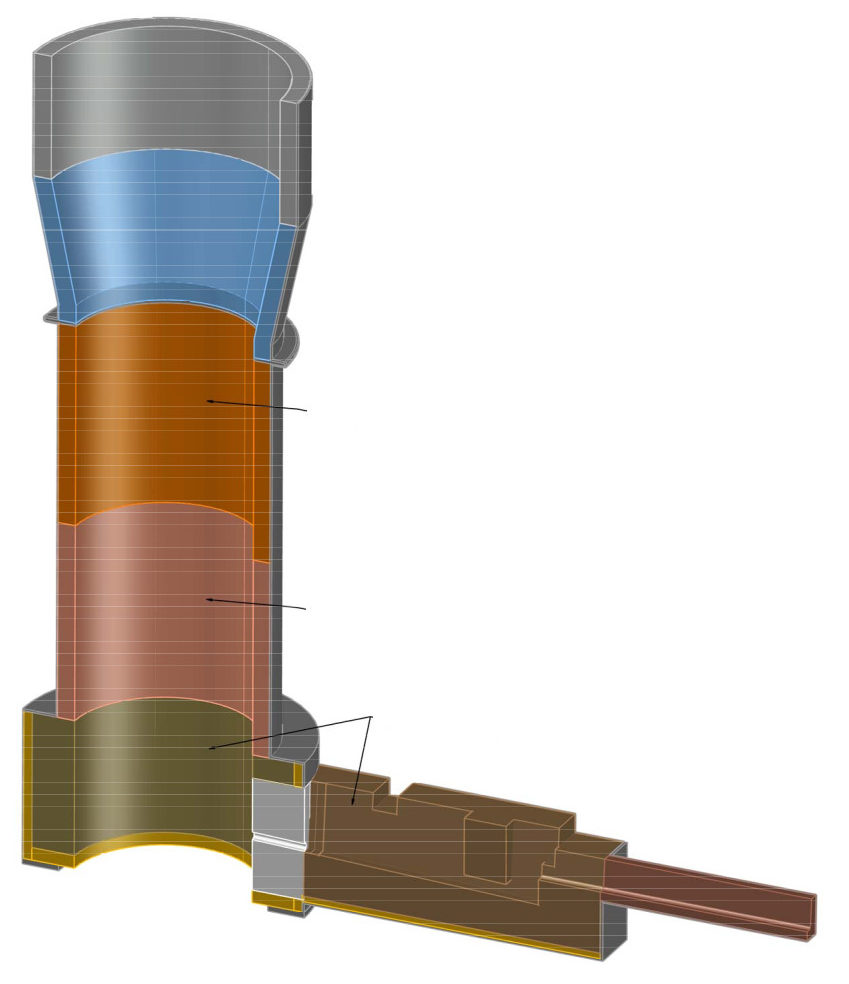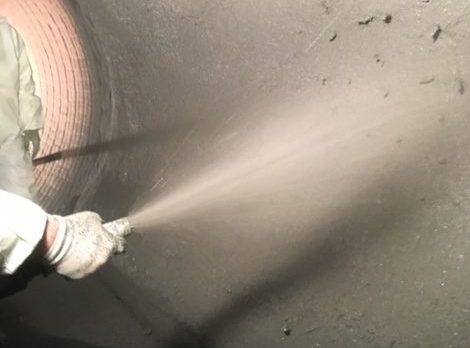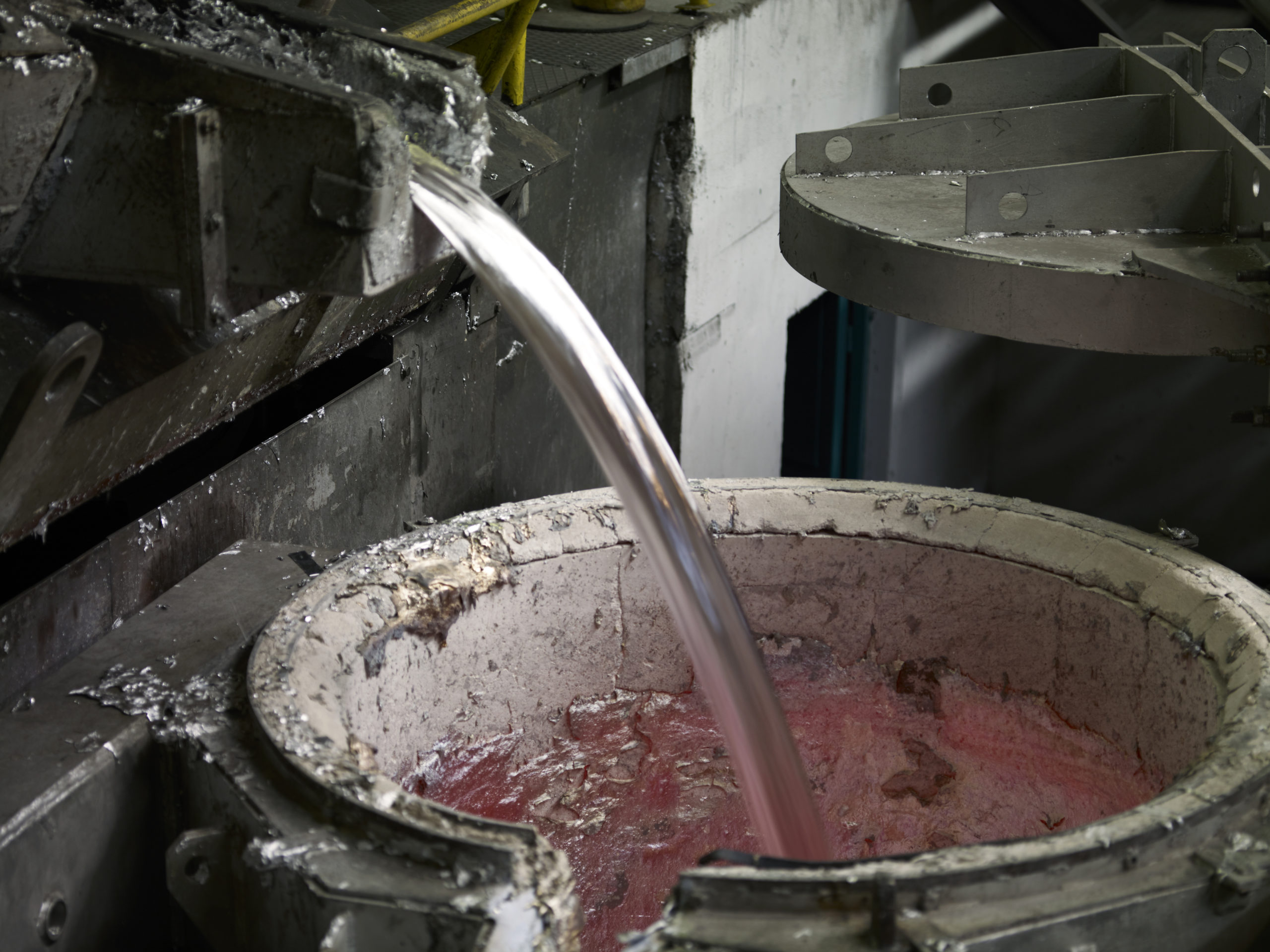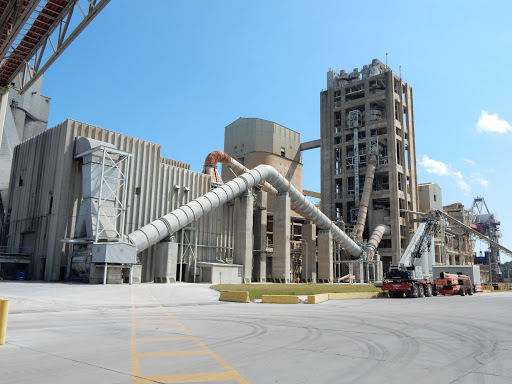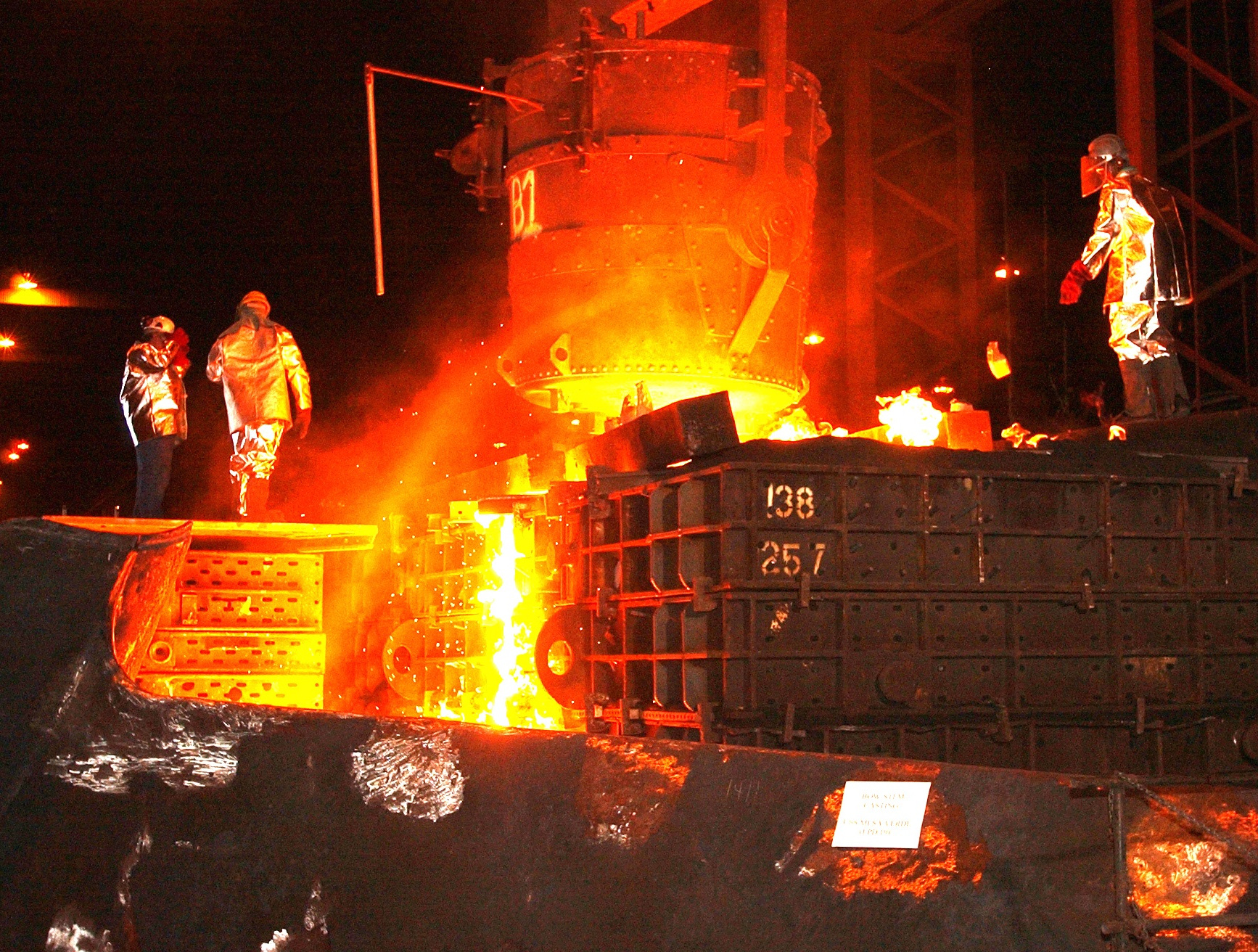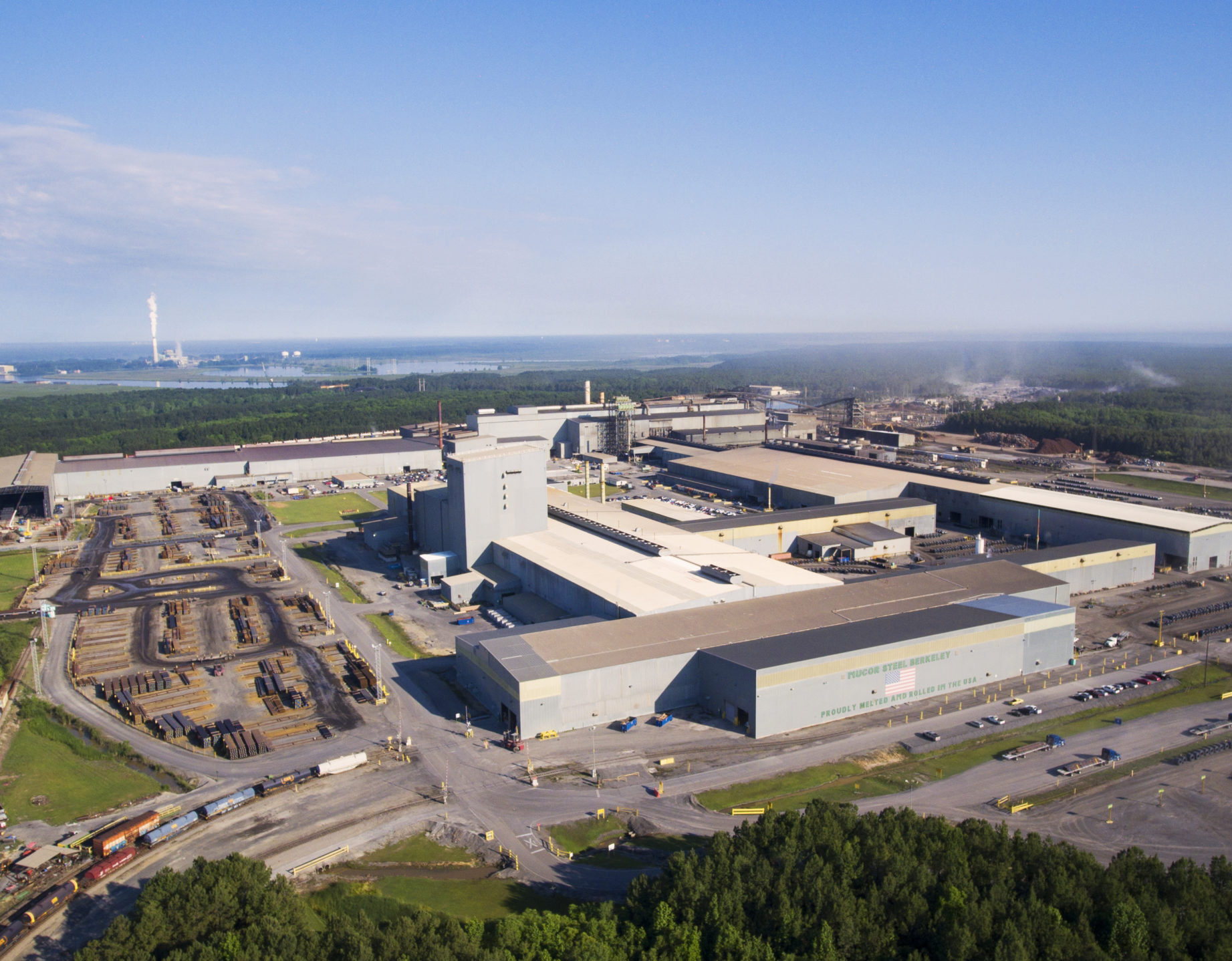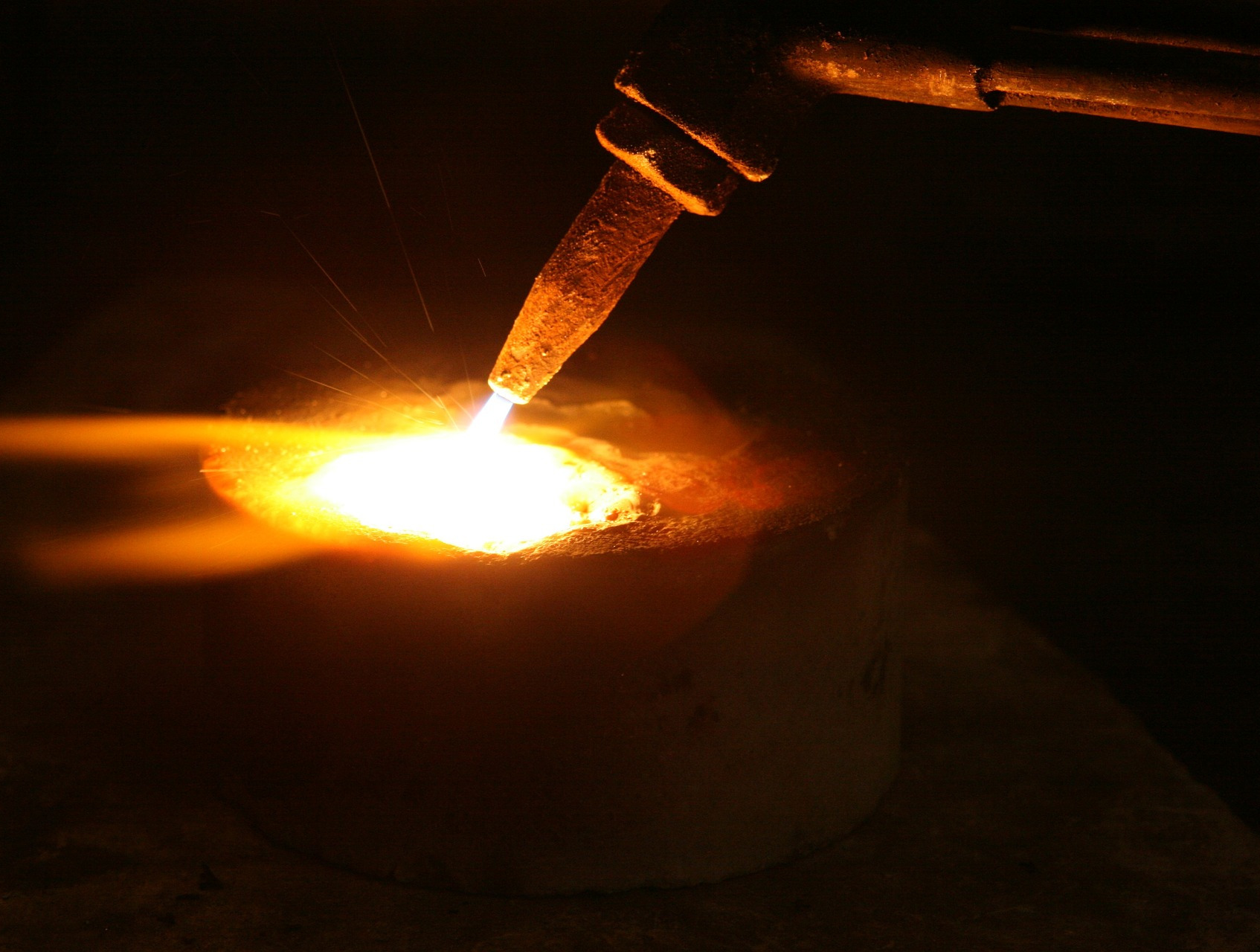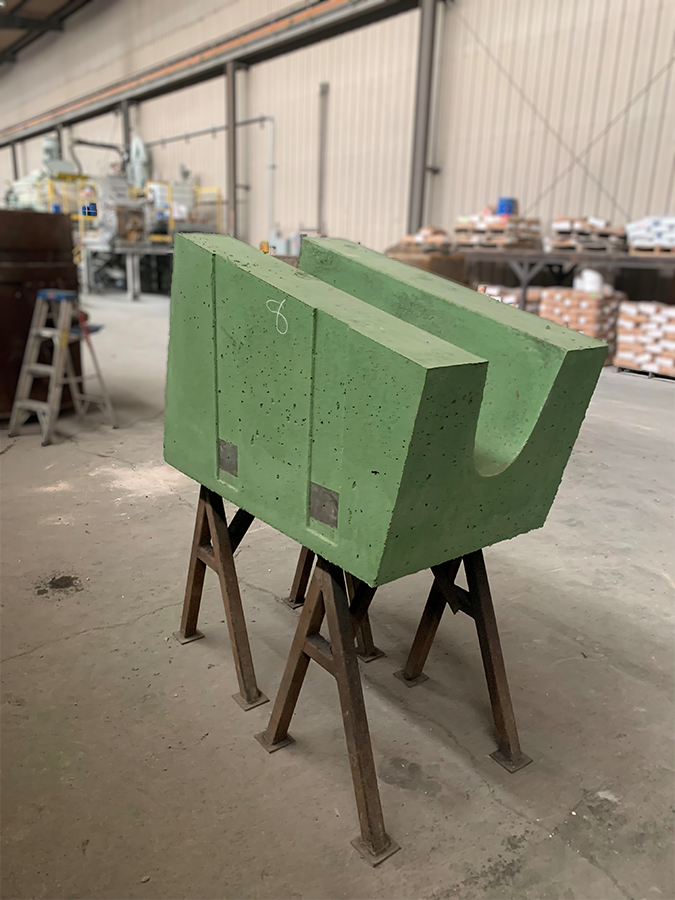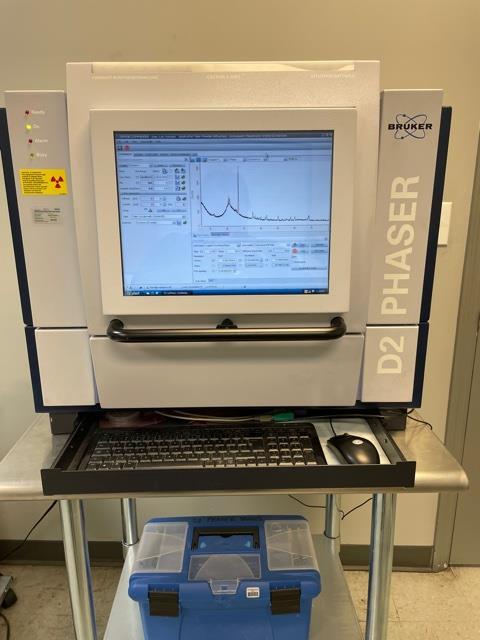Facilities, Expertise, and Advanced Product Technology
The RENO Team has a long history of supplying iron foundries with high-quality refractory products, ladles, tear-out and reline services, and pre-cast specialty items. Foundries that take advantage of our scientifically advanced products enjoy higher profits through increased production, scrap reductions, energy savings, or ergonomic benefits, versus the standard purchasing goals for reduced item costs. We are pleased to raise the standard for our offerings with our newest and most advanced refractory technology, RENO ElectroCast™, and our Mastermelt DE-OX Product Line.
Cupola Furnaces
RENO has set the standards for long running cupola campaigns. These furnaces melt high ratios of steel and iron scrap along with digesting many contaminants. Each zone requires special attention. For example, a ductile pipe plant will require combustion and a melt zone refractory much different than furnaces melting automotive castings.
RENO is recognized as the industry leader for cupola refractory technology. We employ our US Patented Shot-Crete RENO Jet Cast™, and our US Patented No-Cement Gunning Method, RENO NC Gun™, for the majority of the refractory linings used in the high production cupola furnaces throughout North America.
Well (Wall & Floor Safety/Hot Face/Maintenance)
4.5” Arch Brick (walls) Straights (floors) x 70% Low Iron Brick
RENO ElectroCast™ 316 SiC
RENO NC Gun 6044
Combustion & Melt Zones (Ductile Pipe Plant)
Well to 10′ above Tuyeres RENO ElectroCast™ SP 392, Cast and Dried or Precast Design. Ductile Pipe Plant Hottest temperatures, and exposure to High amounts of Ferrous Oxides in the slag, similar to a steel melting furnace.
Cupola Furnace applications
Maintenance
RENO NC Gun 90, RENO Gun SP 92, Ductile Pipe
RENO NC Gun 6044 HT, Automotive Castings
RENO NC GUN 85 SIC, Iron and steel
Pre-Heat and Charge Zone
RENO ElectroCast™ 3SB, cast and dried or (Pre-Cast Design Preferred) Many Cupolas use bauxite containing products, 85% Brick, etc. Over time the high iron contents contained in bauxite will allow carbon monoxide to exfoliate the grains and the refractory is destroyed from the inside of the structure.
RENO ElectroShot™ 1170 if the installation method dictates a shot-crete installation.
Combustion Chambers
RENO Jet Cast Super Abrade 60 RENO was the first company to provide shot-crete, this is our premium low cement, alkali resistant product for extreme thermal cycling conditions.
RENO Lite Gun 40 insulates the steel shell and helps reduce the damage from the numerous cycles and thermal shock, as the insulation allows the hot-face refractory to cool at a slower pace than it does without insulation, and it is very easy to install.
Orifice Rings
Precast designs made from Reno Cast 70 KH Hi-Wire Technology
Cross Over Ducts
RENO ElectroShot™ SIL 1199
This application must be tight and stable, our new All Silica based refractory can tolerate the temperature swings easily and remain slick in service due to the extremely low pore size openings. Silica is a very good insulation mineral to keep the steel cool.
Cupola Bottom
The cupola bottom requires refractory products that match the length of the campaign. RENO Bottom Sand is used for short campaigns as a bottom door covering insulation. RENO Cupola Bottom Ram is installed over the RENO Bottom Sand, for a refractory cap. For some plants, they extend the campaign to six months, in these circumstances, RENO Rock BTW Ram is installed over the top of the RENO Cupola Bottom Ram; no Bottom Sand is used for these long campaigns due to the thermal expansion and contraction characteristics of silica.
Tap Hole
Pre-Cast Block made with RENO ElectroCast™ SP 392
RENO ElectroCoat™ Vapor Shield is used as a surface treatment inside the tap-hole cavity
RENO Rock BTW Plastic rammed around to seal the block
Many cupolas start up with an open tap-hole. This super-hot blast air can oxidize the carbon containing surfaces of castables or resin bonded plastics, and shorten the tap-hole’s useful life. RENO’s new ElectroCoat™ Vapor Shield Technology seals the porosity with almost zero permeability which shields the carbon inside the refractory from the hot blast air at start up. This small step can provide much longer performance time.
Front Slagging Trough
RENO NC 90 SiC castable as the safety lining next to the steel shell
RENO ElectroCast™ 316 SiC as the hot face working lining
The front trough hot face must experience and resist 100% of the molten iron and slag produced in the cupola. The most extreme wear is experienced at the cut-line, the metal/slag mixture as this is the most corrosive portion of the layered bath. Velocity and temperatures can affect the wear rates, as well as the metals / alloys / limestone mixtures charged into the cupola. While we cannot control the operational factors, we can offer general rules that can impact the refractory performances; these are: Shape, Safety Lining Selection, and Hot Face Refractory Selection.
Shape
The trough’s hot-face surface can benefit from slowing the velocity of the slag swirling against the slag dam, and circulating back and out of the side cut exit channel. It is imperative to keep the slag chute free and open which reduces the total quantity of slag carried in the trough. Another action that can be done is to reduce the sidewall thickness at the top of the trough to form a V-Shape. This will provide a wider pool which will reduce the height of the slag bath. By using the refractory products selected, this can be safely done in steps, until the pool is enlarged as much as possible. The wider opening also helps when patching as it gives more space if ramming a plastic patch, etc.
Safety Lining 33% of Thickness
Our safety lining, RENO NC 90 SiC, is a 90% containing silicon carbide, no-cement castable. This product is key as it has the highest thermal conductivity to rapidly transfer the heat away from the hot-face. Faster heat sinks, will slow the corrosion at the surface and extend wear rates.
Hot Face Refractory 67% Thickness
The hot face must exhibit high hot strengths to resist the metal and slag rubbing against the sides, as well as the temperatures of the corrosive mixtures. At the cut line, you will see a concave line as if the bath is eating away in a “C-Shape.” Many factors are at play such as miniature explosions of lighting created by the electrical static electricity generated by the passing iron on the grounded refractory. These miniature storms are pushing gases into the refractory structure – this is why the cut line extends above the metal / slag line. These hot dirty gases are the reason; they are being forced into the surface when these electrical charges take place. The only effective way to combat this is to seal the permeability of the refractory structure and prevent these gases from penetrating the structure. RENO’s new scientific breakthrough in refractory bonding technology, RENO ElectroCast™, has produced products unknown to science before now, with almost zero permeability, and extremely high hot strengths. These new characteristics provide the longest lasting refractory for cupola trough campaigns.
Vertical Channel Furnaces
Refractory performance is critical for these furnaces, holding or melting iron. The following products have extended the performance life due to their ability to withstand thermal cycling, slag removal and increased production rates. Coupled with our Mastermelt DE-OX, energy savings, due to free flowing inductor loops, carbon and silicon losses are eliminated and reduced slag volumes are setting new operational standards.
Throat & Floor
RENO ElectroCast™ SP 392
While cleaning, the oxygen lance can damage silicon carbide bearing refractory below metal line. This product contains zero carbon, for safer conditions.
Insulation and Safety
Floor: ½” Marinite Board, + 3” of 70% Brick
Throats: ¼” Microtherm Overstitch Panels, folded under the brick work
Channel Holding Furnace applications
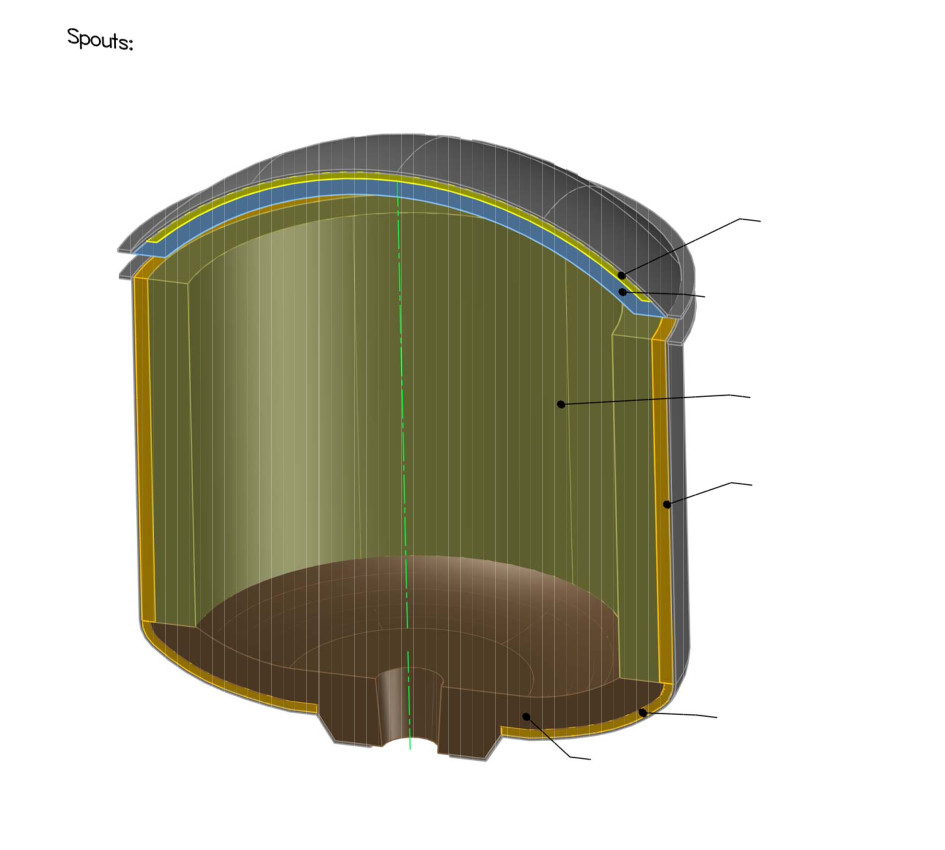
Walls
Insulation and Safety: RENO Coat It AL on Steel Walls, prevents carbon transfer
4.5” Super Duty Brick, arch type for tight construction; 1.5 inches of BNZ 2600°F IFB for Insulation RENO MO Super 3 Mortar. New Insulation-design, reduces energy consumption while providing a true safety liner. The freeze plane is well in front of the brick safety lining.
Hot Face: RENO ElectroCast™ 316 SiC, and RENO ElectroCast™ 310 SiC
RENO’s new advanced electro-bonded technology is used for designing the hot-face refractory compositions with super low permeability, and extremely high hot strengths. The attributes contribute to the long-lasting performance and clean interior walls which increases iron melting efficiencies, and reduces electrical power consumption. “Savings for electricity and increased production easily make the refractory cost of no consequence; thus, we provide free refractories when thinking of the cost to savings benefits.”
Roof
Insulation and Anchors: 85% Phos Anchor Brick, and ½ Inch Marinite Board
Hot Face: RENO NC 60 with 3% HCA Fibers
Spouts
Hot Face: RENO ElectroCast™ 310 SiC
Surface Treatment: RENO ElectroCoat™ 75 SiC
Mastermelt Additive
Ductile Iron Base: Mastermelt DE-OX D-1
Gray Iron Base: Mastermelt De-OX
These additives are used to eliminate the oxygen molecules contained in the molten iron. These oxygen molecules are extremely hyper-reactive, and combine in a fraction of time to form spinel formations such as calcium oxide, magnesium oxide, and other tramp element combinations. Since the loop is circulating the metal and the water-cooled bushings create a strong thermal gradient to keep the refractory from melting away, these spinel formations readily stick to the inside of the inductor loops, and form crusts. These crusts reduce the interior cross sectional areas and thus reduce the amounts of electrical current used for conduction and the melting rates slow, while energy consumption soars. Many plants incorporate a cleaning method known as super heating. This is an uncontrolled event and is used to melt away the interior crusts. While it is expensive, it is also dangerous for the refractory compositions making up the loop channels. With Mastermelt DE-OX for GRAY IRON, and Mastermelt DE-OX D-1 for DUCTILE BASED IRON, (Low Sulfur) provides the foundry melt managers with a tool to clean away the buildups and restore the conductance ratios back to nominal states. This new technique is made possible by the science of the Mastermelt TECHNOLOGY.
Another benefit is the change in the slag consistency as the glassy sticky mess is converted to dry lumps that is easily removed.
Coreless Induction Melting Furnaces
Elephant Foot Wear Zone
Precast impact bowl, made with Reno ElectroCast™ SP 392. This zone experiences temperature swings with the pressure from charging, discharging and variances in electric power forces. The high turbulence washes away the surface glass formed with silica / boron compounds and leads to shorter life. RENO has designed a new concept for combatting the wear mechanisms with our new RENO ElectroCast™ SP 392 product, and our Reno Sil 0.6 as the safety lining. The benefits are much longer campaigns, which reduce hazardous silica exposures for the personnel. Also, less frequent relines offer more production time.
Cover (Insulation and Anchors/Hot Face/Surface Treatment)
85% Phos. Anchor Brick, and ½ Inch Marinite Board
RENO NC 60 with 3% HCA Fibers
RENO ElectroCoat™ 75 SiC
Walls and Floor
RENO’s proprietary Pure Silica Refractory is not made from the traditional low cost quartz found in most competitors’ products. Our product is made from Silica Rock with much smaller crystals that can tolerate rapid heating and cooling for longer performance life, especially true with the higher-powered medium frequency furnaces producing ductile-based iron.
RENO Sil 0.6 for the Floor and Lower Walls
RENO Sil 1.0 for the Upper Walls and Top Cap
Spouts
Hot Face Precast made from Reno ElectroCast™ 370 with 3% HCA Fibers
Surface treatment RENO ElectroCoat™ SP
Lower Rings
Reno Cast 95 LCT The higher alumina tabular product will transfer the heat faster from the lower walls and floor, and provide additional lining life to the most troublesome areas.
Coreless Induction Melting FCE applications
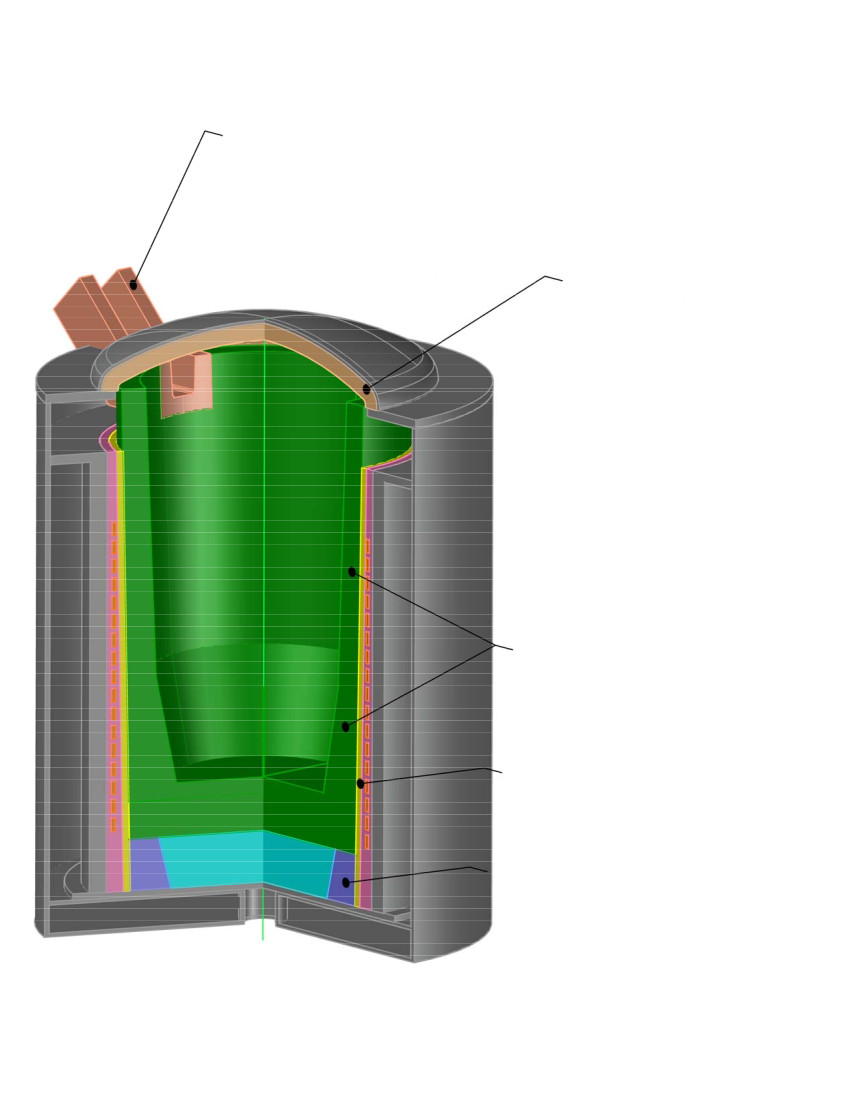
Ductile Treatment Ladle
RENO ElectroCoat™ SP and RENO ElectroCast™ FST
Ductile treating ladles are used for transforming gray iron into nodular or ductile iron. The Magnesia Ferro-Silicon alloys used in this process liberate free magnesia and calcium which rapidly builds on the wall surfaces, requiring heavy cleaning. With RENO’s ElectroCoat™ SP, the castable surface is protected from the magnesia / lime mixtures, and stays clean. This feature allows the ladle to stay in service longer which reduces the cleaning cycles, which saves labor and repair products.
Hot Face / Surface Treatment
RENO ElectroCoat™ SP
Magnesia Fade is a common problem throughout the ductile iron making industry. If one examines the slag adherences, the compositions are mainly magnesia + calcium + silica; the alloys used for nucleating the carbon flakes into spheres for ductile iron. The magnesia is attracted to silica, which is inherent in most refractory products. RENO has taken our new Electro technology and produced a near zero permeable structure surface treatment that contains zero silica and thus inhibits the magnesia transfer. Rather than the sometimes used magnesia lightweight air-setting products, that have little strength, our RENO ElectroCoat™ SP is robust and strong to resist the violent reactions during inoculation treatments.
Castable Lining
RENO ElectroCast™ FST
Another major technology first is RENO’s Synthesized Mineral in combination with our Electro Technology. This product also is silica free and will behave similar to pure mullite in it’s ability to tolerate thermal cycling. Combining the working surface and the castable back up will provide much longer campaigns before removing for cleaning and reduce the very expensive amounts of alloys to provide carbon nucleation.
Safety Interior Steel Surface Treatment
RENO Coat It AL, Prevents Carbon Transfer
Treatment Ladle applications
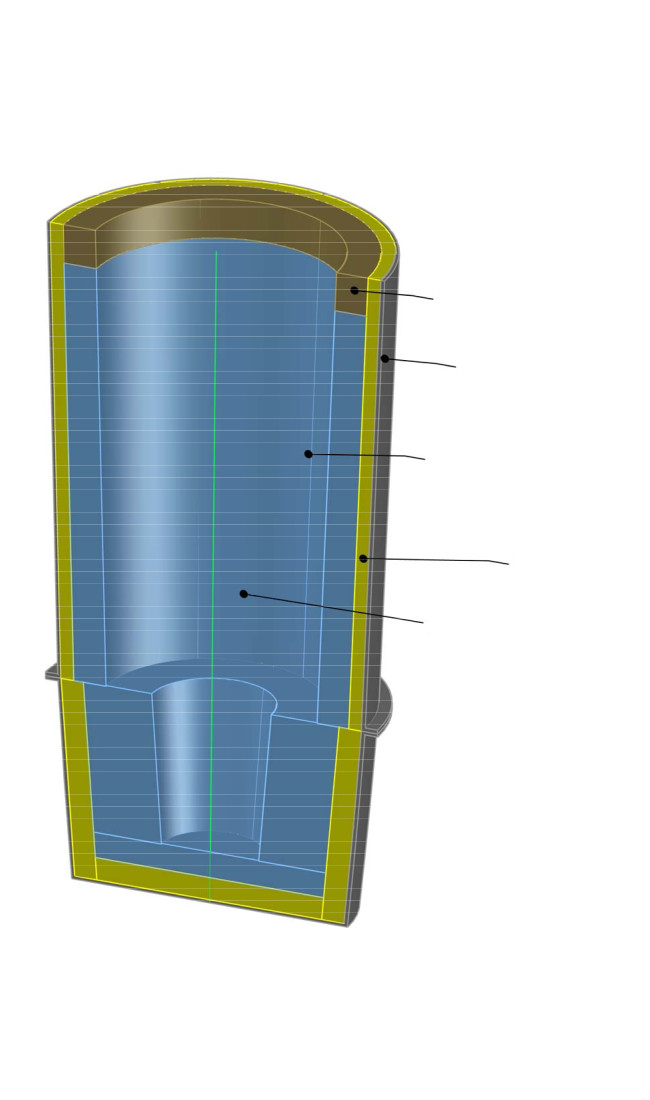
Benefits
Reduced alloy costs, reduced cleaning labor, decreases safety and workers’ compensation claims, increased production and higher quality as the interior remains a stable size for accurate alloy additions, insulation, and safety liner.
Insulation
2800° F, IFB Brick Split / RENO MO Super 3 Mortar
Top Compression Cap
It is imperative to keep the castable working lining in compression to avoid horizontal cracking. This can be accomplished by incorporating:
3/8” diameter x # 304 V-Anchors x length of approximately 80% of thickness, welded on 6-inch centers
4 ~ 6-Inch top-cap of RENO Cast 70 KH /Hi Wire.
This economical solution can be cast along with castable but the high volume of steel fibers adds a robust in the field thrust plate barrier to keep the ladle in compression which eliminates cracks and increases refractory life.
Porous Plug, De-Sulphurization Ladles — “Bubbling Pots”
RENO Refractories, Inc. is proud of our world-leading no-cement nano-bonded colloidal silica products.
RENO NC Nano-Tech Technology
All of our NC products provide properties that are unmatched, by any other refractory supplier; these are:
- Low Permeability
- Resists Penetrations
- Super High Hot Strengths
- Impact Resistance
- Pore Sizes are 2-3 Microns
- Molten Slags do not Wet the Structure
- Abrasion Values below 6 CC Loss
- Lasts Longer with High Turbulence
Bubbling Pot applications
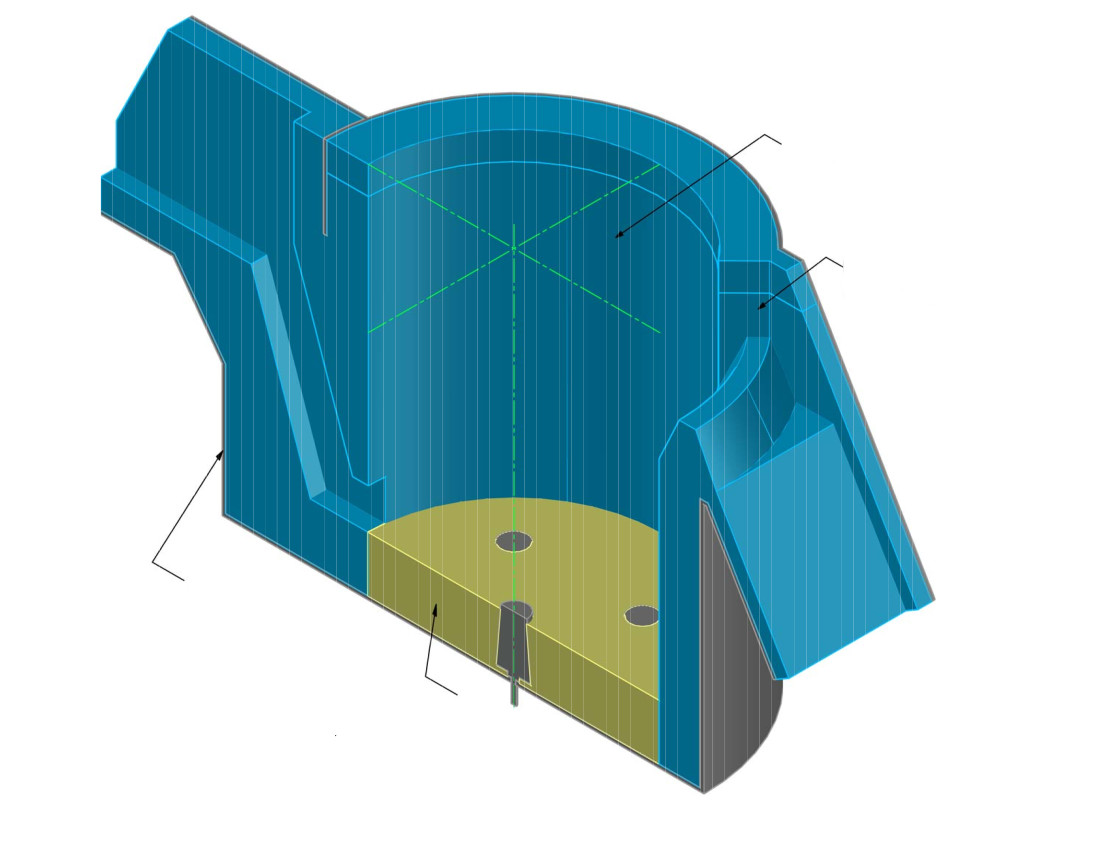
Hot Face/Surface Treatment
RENO ElectroCoat™ 75 SiC
RENO has taken the new Electro technology and produced a near zero permeable structure surface treatment that contains high levels of Silicon Carbide. RENO ElectroCoat™ SP is robust and strong to resist the violent reactions during inoculation treatments.
Castable Lining
RENO NC 6059 Coarse
RENO uses the strength of an all bauxite product with silicon carbide to further increase thermal shock resistance and reduce surface corrosions form the high levels of lime and spar fluxes.
Floor
RENO NC 60
This no cement castable will last longer and is easier to remove than the coarse grained wall lining when replacing the porous plugs.
Safety Steel Surface Treatment
RENO Coat It AL, Prevents Carbon Transfer
Insulation
2800°F IFB Brick Split / RENO MO Super 3 Mortar
Top Cap
It is imperative to keep the castable working lining in compression to avoid horizontal cracking; this can be accomplished by incorporating:
3/8” diameter x # 304 V-Anchors welded every 6-inches apart
4 ~ 6-Inch top-cap of RENO Cast 70 KH HI WIRE
This economical solution adds a robust in the field thrust plate barrier to keep the ladle in compression, which eliminates cracks, and increases refractory life.
Ductile Iron Pour Pressure Furnace
Increased Production, and Reduced Cleaning
While in service, the magnesia and calcium carried over from the alloys used in the inoculation process, tends to create a viscous slag layer that can build up on the walls and throat areas. These adherences are very difficult to remove, requiring dangerous hot work to be done on a regular basis. These cleaning activities, reduces valuable production time.
Our super low permeable refractory products, used in many auto-pour and pressure pour furnaces have greatly increased the production time intervals between these cleaning activities, and have lessened the time required to perform the actual cleaning, and increased the refractory life.
Competitive Low Cement Products display a pore size of 20-30 microns.
Our no cement, NC products using the sol gel binder system display pores of 1-2 microns.
RENO ElectroCast™ Products only exhibit pores of 0.5 ~ 0.1 microns!
Pressure Pour Furnace applications
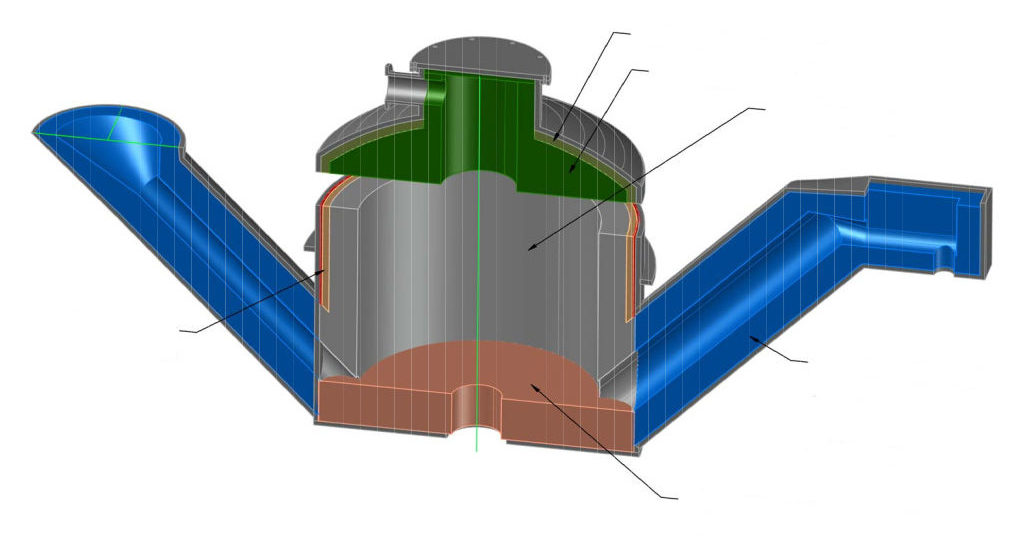
Throat & Floor
Reno ElectroCast™ SP 392
While cleaning, the oxygen lance can damage silicon carbide bearing refractory below metal line. This product contains zero carbon, for safer conditions
Insulation & Safety
Floor: ½” Marinite Board, + 3” of 70% Brick
Throats: ¼” Microtherm Overstitch Panels, folded under the brick work
Roof
Insulation and Anchors: 85% Phos Anchor Brick, and ½ Inch Marinite Board
Hot Face: RENO NC 60 with 3% HCA Fibers
Spouts
Hot Face: RENO ElectroCast™ FST
Surface Treatment: RENO ElectroCoat™ SP
Walls
Insulation and Safety:
RENO Coat It AL on Steel Walls, prevents carbon transfer
4.5” Super Duty Brick, arch type for tight construction
1.5 inches of BNZ 2600° F IFB for Insulation
RENO MO Super 3 Mortar
Hot Face:
RENO ElectroCast™ FST
RENO has invested in a new synthetic mineral made exclusively for us. This mineral can tolerate thermal swings, and is non wetting while in contact with iron. Zero Silica composition prevents magnesium fade from ductile iron. Cleaning is made easy and less frequent. New insulation design reduces energy consumption while providing a true safety liner. The freeze plane is well in front of the brick safety lining.
Pouring Boxes, with Stopper Rods
RENO NC 6059 Coarse, RENO ElectroCoat™ 75 SiC, RENO NC 908
Pouring Boxes are a constant source of maintenance, as the indexing molds require even and consistent filling via a nozzle and stopper rod assembly. RENO provides the longest casting solutions with our novel pre-cast Nozzles which dispenses the metal in a constant clean flow rates that do not require the continuous stoppage of the molding lines in order to clean, “ROD-OUT” the nozzles. RENO’s innovative designs allow the interior surfaces to run cleaner and longer for reduced change out sequences, which provides more castings and lower costs.
Pouring Box applications
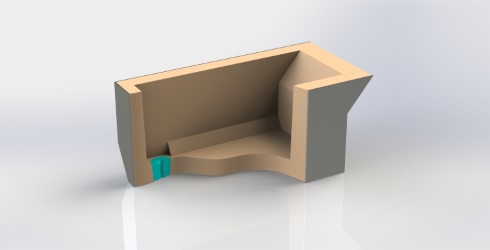
Hot Face/Surface Treatment
RENO ElectroCoat™ 75 SiC is a robust, near zero permeability, ceramic coating that resists oxidation. This new surface will: extend the on-line performance time without buildups, greatly lessen the cleaning time, and allows the castable working lining to last many times longer.
Castable Lining
RENO NC 6059 Coarse
This rugged refractory castable is engineered to tolerate extreme thermal cycling, very small pore sizes, which reduce adherences, and easy dry-out characteristics.
Precast Nozzles
RENO leads the industry with clean metal dispensing, with pour-box nozzles fabricated with RENO NC 908. This is our calcium free product that is virtually pure alumina and chrome oxide enhanced for clean and dependable mold filling. At the end of the day, the extra molds filled, adds profits for the foundry operation.
Insulation
2800°F, IFB Brick Split / RENO MO Super 3 Mortar
Safety Steel Surface Treatment
RENO Coat It AL
To prevent carbon transfer should molten iron touch the steel shell, which weakens the steel and is the major cause of run-outs, apply this ceramic layer of protection.
Top Cap
It is imperative to keep the castable working lining in compression to avoid horizontal cracking; this can be accomplished by incorporating:
3/8” diameter x # 304 V-Anchors welded on 6-inch centers x a length of approximately 80% of the total lining thickness
4 ~ 6-Inch top-cap of RENO Cast 70 KH, HI WIRE
This economical solution can be cast along with castable but the high volume of steel fibers adds a robust, in the field thrust plate barrier to keep the ladle in compression which eliminates cracks and increases life.
Gray Iron Transfer Ladles
RENO ElectroCast™ 370 and RENO ElectroCoat™ 75 SiC
Grey Iron Transfer Ladles will perform longer and provide lower turnaround maintenance costs when utilizing these advanced refractory products.
Hot Face/Surface Treatment
RENO ElectroCoat™ 75 SiC is a robust, near zero permeability, ceramic coating that resists oxidation. This new surface will: extend the on-line performance time without buildups, greatly lessen the cleaning time, and allows the castable working lining to last many times longer.
Gray Iron Transfer Ladles applications
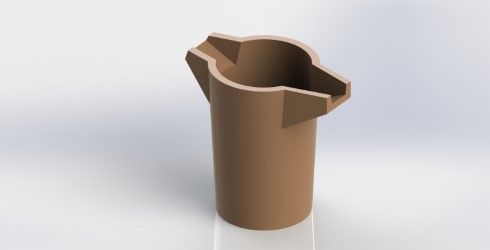
Castable Lining
RENO ElectroCast™ 370
This super refractory is engineered to tolerate thermal cycling and has all the advantages listed for our Electro Castables, such as extremely small pore sizes, and very low permeability to resist adherences, and very high hot strengths to combat erosion.
Insulation
2800°F, IFB Brick Split / RENO MO Super 3 Mortar
Safety Surface Treatment
RENO Coat It AL
To prevent Carbon Transfer should molten iron touch the steel shell, which weakens the steel and is the major cause of run-outs, apply this ceramic layer of protection.
Top Cap
It is imperative to keep the castable working lining in compression to avoid horizontal cracking; this can be accomplished by incorporating:
3/8” diameter x # 304 V-Anchors welded on 6-inch centers x a length of approximately 80% of the total lining thickness
4 ~ 6-Inch top-cap of RENO Cast 70 KH HI WIRE
This economical solution can be cast along with castable but the high volume of steel fibers adds a robust, in the field thrust plate barrier to keep the ladle in compression which eliminates cracks and increases life.
Side Charge Cupola and Trough applications
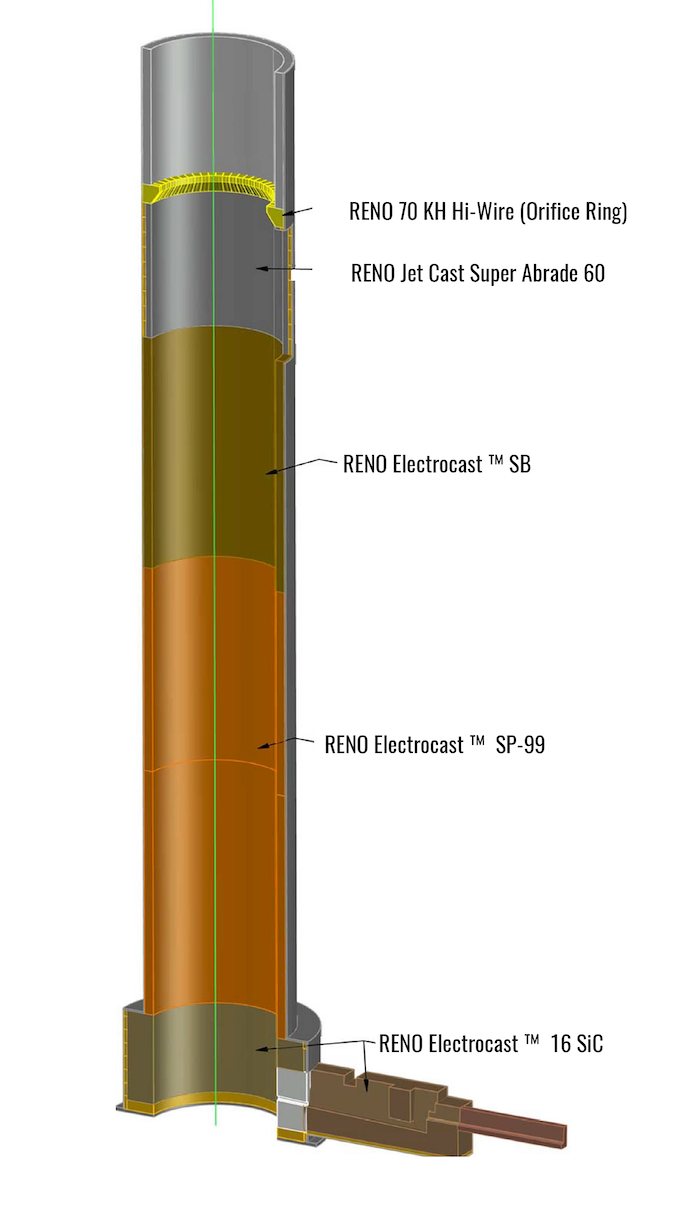
Cupola — 360° Gas Offtake w/ Trough applications
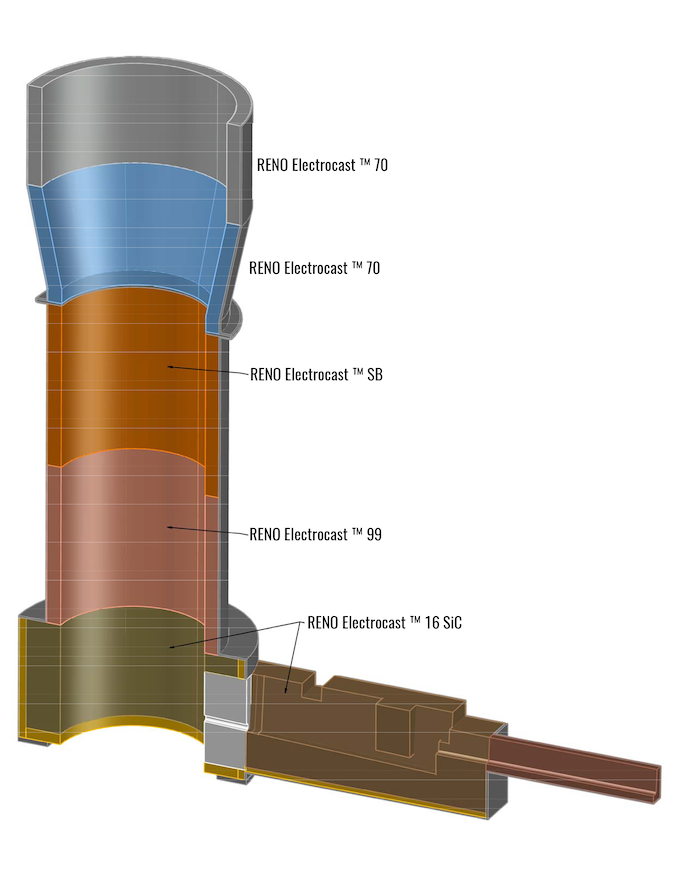
Cupola Furnaces
RENO has set the standards for long running cupola campaigns. These furnaces melt high ratios of steel and iron scrap along with digesting many contaminants. Each zone requires special attention. For example, a ductile pipe plant will require combustion and a melt zone refractory much different than furnaces melting automotive castings.
RENO is recognized as the industry leader for cupola refractory technology. We employ our US Patented Shot-Crete “RENO Jet Cast™,” and our US Patented No Cement Gunning Method, “RENO NC Gun™”, for the majority of the refractory linings used in the high production cupola furnaces throughout North America.
Well (Wall & Floor Safety/Hot Face/Maintenance)
4.5” Arch Brick (walls) Straights (floors) x 70% Low Iron Brick
RENO ElectroCast™ 316 SiC
RENO NC Gun 6044
Combustion & Melt Zones (Ductile Pipe Plant)
RENO ElectroCast™ SP 392, Cast and Dried or Pre-Cast Design, Hottest temperatures, and exposure to High amounts of Ferrous Oxides in the slag, similar to a steel melting furnace
Maintenance
RENO NC Gun 90, RENO Gun SP 92, Ductile Pipe
RENO NC Gun 6044 HT, Automotive Castings
RENO NC GUN 85 SIC, Iron and steel
Pre-Heat and Charge Zone
RENO ElectroCast™ 3SB, cast and dried or (Pre-Cast Design Preferred) Many Cupolas use bauxite containing products, 85% Brick, etc. Over time the high iron contents contained in bauxite will allow carbon monoxide to exfoliate the grains and the refractory is destroyed from the inside of the structure.
RENO ElectroShot™ 1170 if the installation method dictates a shot-crete installation.
Combustion Chambers
RENO Jet Cast Super Abrade 60 RENO was the first company to provide shot-crete, this is our premium low cement, alkali resistant product for extreme thermal cycling conditions.
RENO Lite Gun 40 insulates the steel shell and helps reduce the damage from the numerous cycles and thermal shock, as the insulation allows the hot-face refractory to cool at a slower pace than it does without insulation, and it is very easy to install.
Orifice Rings
Precast designs made from Reno Cast 70 KH Hi-Wire Technology
Cross Over Ducts
RENO ElectroShot™ SIL 1199
This application must be tight and stable, our new All Silica based refractory can tolerate the temperature swings easily and remain slick in service due to the extremely low pore size openings.
Tap Hole
Pre-Cast Block made with RENO ElectroCast™ SP 392
RENO ElectroCoat™ Vapor Shield is used as a surface treatment inside the tap-hole cavity
RENO Rock BTW Plastic rammed around to seal the block
Many cupolas start up with an open tap-hole. This super-hot blast air can oxidize the carbon containing surfaces of castables or resin bonded plastics, and shorten the tap-hole’s useful life. RENO’s new ElectroCoat™ Vapor Shield Technology seals the porosity with almost zero permeability which shields the carbon inside the refractory from the hot blast air at start up. This small step can provide much longer performance time.
Front Slagging Trough
RENO NC 90 SiC castable as the safety lining next to the steel shell
RENO ElectroCast™ 316 SiC as the hot face working lining
The front trough hot face must experience and resist 100% of the molten iron and slag produced in the cupola. The most extreme wear is experienced at the cut-line, the metal/slag mixture is the most corrosive portion of the layered bath. Velocity and temperatures can affect the wear rates, as well as the metals, alloys, and limestone mixtures charged into the cupola. While we cannot control the operational factors, we can offer general rules that can impact the refractory’s performance; these are: Shape, Safety Lining Selection, and Hot Face Refractory Selection.
Shape
The troughs hot-face surface can benefit from slowing the velocity of the slag swirling against the slag dam, and circulating back and out of the side cut exit channel. It is imperative to keep the slag chute free and open, which reduces the total quantity of slag carried in the trough. Another action that can be done is to reduce the sidewall thickness at the top of the trough to form a V-Shape. This will provide a wider pool which will reduce the height of the slag bath. By using the refractory products selected, this can be safely done in steps, until the pool is enlarged as much as possible. The wider opening also helps when patching as it gives more space if ramming a plastic patch, etc.
Safety Lining 33% of Thickness
Our safety lining, RENO NC 90 SiC, is a 90% containing silicon carbide, no-cement castable. This product is key as it has the highest thermal conductivity to rapidly transfer the heat away from the hot-face. Faster heat sinks, will slow the corrosion at the surface and extend wear rates.
Hot Face Refractory 67% Thickness
The hot face must exhibit high hot strengths to resist the metal and slag rubbing against the sides, as well as the temperatures of the corrosive mixtures. At the cut line, you will see a concave line, as if the bath is eating away in a “C-Shape.” Many factors are at play, such as miniature explosions of lighting created by the electrical static electricity generated by the passing iron on the grounded refractory. These miniature storms are pushing gases into the refractory structure – this is why the cut line extends above the metal / slag line. These hot dirty gases are the reason; they are being forced into the surface when these electrical charges take place. The only effective way to combat this is to seal the permeability of the refractory structure and prevent these gases from penetrating the structure. RENO’s new scientific breakthrough in refractory bonding technology, RENO ElectroCast™, has produced products unknown to science before now, with almost zero permeability, and extremely high hot strengths, these new characteristics provide the longest lasting refractory for cupola trough campaigns.
New Advanced Technologies:
RENO ElectroCast™ Technology
- Almost Zero Permeability
- No Alkali or Iron Oxide Penetrations
- Super High Hot Strengths
- Impact Resistance
- Pore Sizes below 1-micron
- Molten Slags do not Wet the Structure
- Abrasion Values below 3 CC Loss
- Lasts Longer with High Volume Charging
- Lower Modulus of Elasticity
- Resists Thermal Cycling Damage
Mastermelt DE-OX
When Mastermelt DE-OX is injected through the tuyeres, iron oxide inside the cupola is eliminated. The oxidizing waste for carbon and silicon losses disappear. Temperature, chemistry and production controls are now achievable with a much more efficient furnace. The overwhelming savings are realized with coke and silicon savings.
Channel Holding Furnace applications
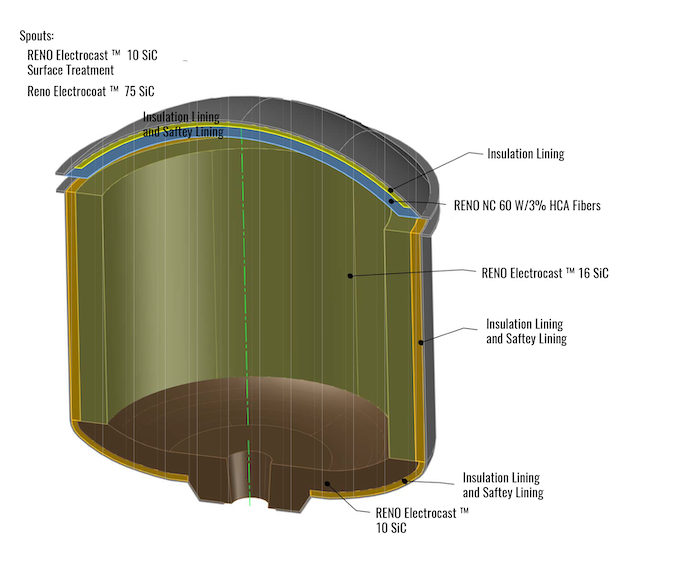
- RENO Electrocast™ 310 SiC
- Surface Treatment: RENO ElectroCoat™ 75 SiC
- Insulation Lining
- RENO NC 60 w/ 3% HCA Fibers
- RENO Electrocast™ 316 SiC
- RENO ElectroCast™ SP 392
Channel Induction Furnaces
Refractory performance is critical for these furnaces, holding or melting iron. The following products have extended the performance life due to their ability to withstand thermal cycling, slag removal, and increased production rates. Coupled with our Mastermelt DE-OX, these products will create massive energy savings, due to free flowing inductor loops, carbon and silicon losses that are eliminated, and reduced slag volumes that are setting new operational standards.
Throat & Floor
RENO ElectroCast™ SP 392
While cleaning, the oxygen lance can damage silicon carbide bearing refractory below metal line. This product contains zero carbon, for safer conditions.
Insulation and Safety
Floor: ½” Marinite Board, + 3” of 70% Brick
Throats: ¼” Microtherm Overstitch Panels, folded under the brick work
Walls
Insulation and Safety: RENO Coat It AL on Steel Walls, prevents carbon transfer
4.5” Super Duty Brick, arch type for tight construction; 1.5 inches of BNZ 2600°F IFB for Insulation RENO MO Super 3 Mortar. New Insulation-design, reduces energy consumption while providing a true safety liner. The freeze plane is well in front of the brick safety lining.
Hot Face: RENO ElectroCast™ 316 SiC, and RENO ElectroCast™ 310 SiC
RENO’s new advanced electro-bonded technology is used for designing the hot-face refractory compositions with super low permeability, and extremely high hot strengths. The attributes contribute to the long-lasting performance and clean interior walls which increases iron melting efficiencies, and reduces electrical power consumption. “Savings for electricity and increased production easily make the refractory cost of no consequence; thus, we provide free refractories when thinking of the cost to savings benefits.”
Roof
Insulation and Anchors: 85% Phos Anchor Brick, and ½ Inch Marinite Board
Hot Face: RENO NC 60 with 3% HCA Fibers
Spouts
Hot Face: RENO ElectroCast™ 310 SiC
Surface Treatment: RENO ElectroCoat™ 75 SiC
Mastermelt Additive
Ductile Iron Base: Mastermelt DE-OX D-1
Gray Iron Base: Mastermelt De-OX
These additives are used to eliminate the oxygen molecules contained in the molten iron. These oxygen molecules are extremely hyper-reactive, and combine in a fraction of time to form spinel formations such as calcium oxide, magnesium oxide, and other tramp element combinations. Since the loop is circulating the metal and the water-cooled bushings create a strong thermal gradient to keep the refractory from melting away, these spinel formations readily stick to the inside of the inductor loops, and form crusts. These crusts reduce the interior cross sectional areas and thus reduce the amounts of electrical current used for conduction and the melting rates slow, while energy consumption soars. Many plants incorporate a cleaning method known as super heating. This is an uncontrolled event and is used to melt away the interior crusts. While it is expensive, it is also dangerous for the refractory compositions making up the loop channels. With Mastermelt DE-OX for GRAY IRON, and Mastermelt DE-OX D-1 for DUCTILE BASED IRON, (Low Sulfur) provides the foundry melt managers with a tool to clean away the buildups and restore the conductance ratios back to nominal states. This new technique is made possible by the science of the Mastermelt TECHNOLOGY.
Another benefit is the change in the slag consistency as the glassy sticky mess is converted to dry lumps that is easily removed.
Coreless Induction Melting FCE applications
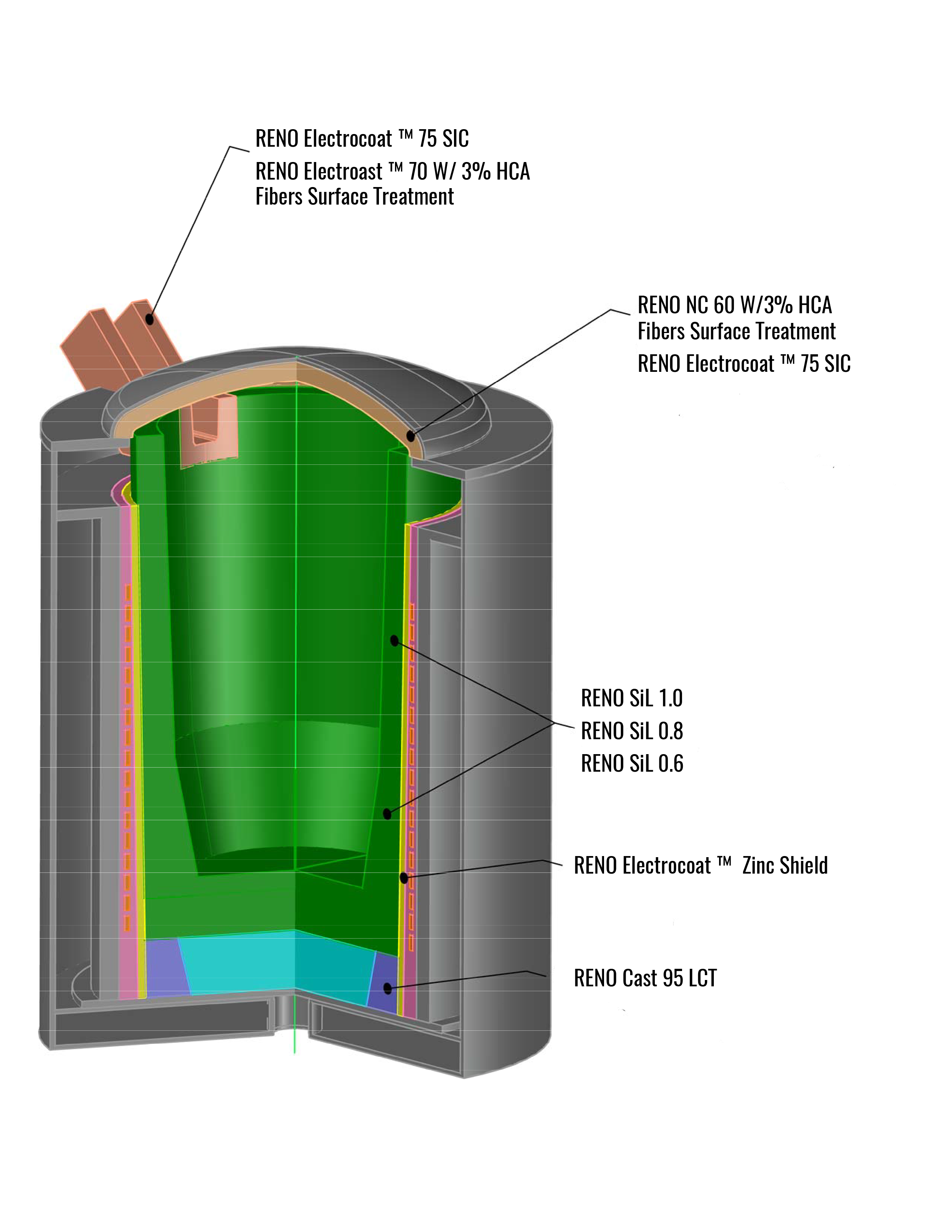
- RENO Electrocast™ 370 w/ 3% HCA Fibers
- Surface Treatment: RENO Electrocoat™ SP
- RENO NC 60 w/ 3% HCA Fibers
- Surface Treatment: RENO Electrocoat™ 75 SiC
- RENO SiL 1.0
- RENO SiL 0.8
- RENO SiL 0.6
- RENO Cast 95 LCT
RENO Sil 0.6 and RENO Sil 1.0
RENO’s proprietary Pure Silica Refractory is not made from the traditional low cost quartz found in most competitors’ products. Our product is made from Silica Rock with much smaller crystals that can tolerate rapid heating and cooling for longer performance life, this is especially true with the higher powered, medium frequency furnaces producing ductile based iron.
New RENO ElectroCast™ Technology
These new products provide properties that are unmatched by any other refractory supplier; such as:
- Almost Zero Permeability
- No Alkali or Iron Oxide Penetrations
- Super High Hot Strengths
- Impact Resistance
- Pore Sizes below 1-micron
- Molten Slags do not Wet the Structure
- Abrasion Values below 3 CC Loss
- Lasts Longer with High Volume Charging
Elephant Foot Wear Zone
Precast impact bowl, made with Reno ElectroCast™ Sp 392. This zone experiences temperature swings with the pressure from charging, discharging and variances in electric power forces. The high turbulence washes away the surface glass formed with silica / boron compounds and leads to shorter life. RENO has designed a new concept for combatting the wear mechanisms with our new RENO ElectroCast™ SP 392 product, and our Reno Sil 0.6 as the safety lining. The benefits are much longer campaigns, which reduce hazardous silica exposures for the personnel. Also, less frequent relines offer more production time.
Cover (Insulation and Anchors/Hot Face/Surface Treatment)
85% Phos. Anchor Brick, and ½ Inch Marinite Board
RENO NC 60 with 3% HCA Fibers
RENO ElectroCoat 75 SiC
Spouts (Hot Face/Surface Treatment)
Hot Face Precast made from Reno ElectroCast™ 370 with 3% HCA Fibers
Surface treatment RENO ElectroCoat™ SP
Lower Rings
Reno Cast 95 LCT The higher alumina tabular product will transfer the heat faster from the lower walls and floor, and provide additional lining life to the most troublesome areas.
Walls and Floor
RENO’s proprietary Pure Silica Refractory is not made from the traditional low cost quartz found in most competitors’ products. Our product is made from Silica Rock with much smaller crystals that can tolerate rapid heating and cooling for longer performance life, especially true with the higher-powered medium frequency furnaces producing ductile-based iron.
RENO Sil 0.6 for the Floor and Lower Walls
RENO Sil 1.0 for the Upper Walls and Top Cap
Treatment Ladle applications
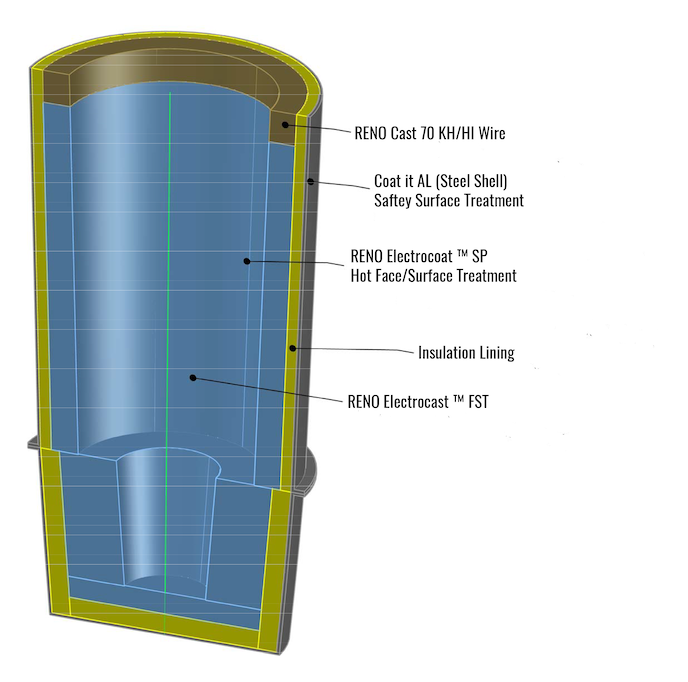
- RENO Cast 70 KH/Hi Wire
- Coat It AL (Steel Shell) Safety Surface Treatment
- RENO Electrocoat™ SP Hot Face/ Surface Treatment
- Insulation Lining
- RENO Electrocast™ FST
Ductile Treatment Ladles
Ductile treating ladles are used for transforming gray iron into nodular or ductile iron. The Magnesia Ferro-Silicon alloys used in this process liberate free magnesia and calcium which rapidly builds on the wall surfaces, requiring heavy cleaning. With RENO’s ElectroCoat™ SP, the castable surface is protected from the magnesia / lime mixtures, and stays clean. This feature allows the ladle to stay in service longer which reduces the cleaning cycles, which saves labor and repair products.
Refractory Surfaces (Hot Face / Surface Treatment)
RENO ElectroCoat™ SP
Magnesia Fade is a common problem throughout the ductile iron making industry. If one examines the slag adherences, the compositions are mainly magnesia + calcium + silica; the alloys used for nucleating the carbon flakes into spheres for ductile. The magnesia is attracted to silica which is inherent in most refractory. RENO has taken the new Electro technology and produced a near zero permeable structure surface treatment that contains zero silica and thus inhibits the magnesia transfer. Rather than the sometimes used magnesia lightweight air-setting products, that have little strength, our RENO ElectroCoat™ SP is robust and strong enough to resist the violent reactions during inoculation treatments.
Castable Lining
RENO ElectroCast™ FST
Another major technology first is RENO’s Synthesized Mineral in combination with our Electro Technology. This product also is silica free and will behave similar to pure mullite in it’s ability to tolerate thermal cycling. Combining the working surface and the castable back up will provide much longer campaigns before removing for cleaning and reduce the very expensive amounts of alloys to provide carbon nucleation.
Safety Surface Treatment
RENO Coat It AL, Pevents Carbon Transfer
Benefits
- Reduced Cleaning Labor
- Increases Safety and Workers’ Compensation Claims
- Increased Production and Higher Quality as the interior remains a stable size for Accurate Additions
Insulation
2800°F, IFB Brick Split / RENO MO Super 3 Mortar
Top Compression Cap
It is imperative to keep the castable working lining in compression to avoid horizontal cracking. This can be accomplished by incorporating:
3/8” diameter x # 304 V-Anchors x length of approximately 80% of thickness, welded on 6-inch centers
4 ~ 6-Inch top-cap of RENO Cast 70 KH /Hi Wire.
This economical solution can be cast along with castable but the high volume of steel fibers adds a robust in the field thrust plate barrier to keep the ladle in compression which eliminates cracks and increases refractory life.
Bubbling Pot applications
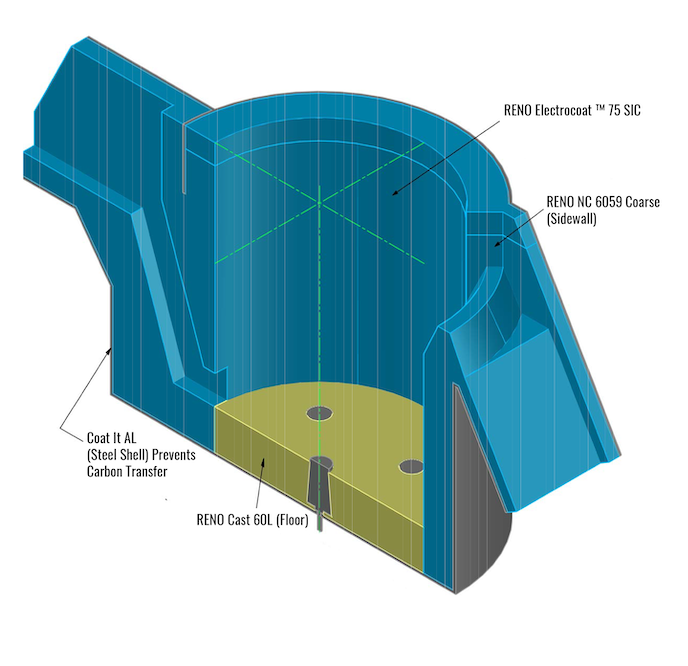
Porous Plug, De-Sulphurization Ladles — “Bubbling Pots”
RENO Refractories, Inc. is proud of our world-leading no-cement, nano-bonded, colloidal silica products.
RENO NC Nano-Tech Technology
All of our NC products provide properties that are unmatched, by any other refractory supplier; these are:
- Low Permeability
- Resists Penetrations
- Super High Hot Strengths
- Impact Resistance
- Pore Sizes are 2-3 Microns
- Molten Slags do not Wet the Structure
- Abrasion Values below 6 CC Loss
- Lasts Longer with High Turbulence
Hot Face/Surface Treatment
RENO ElectroCoat™ 75 SiC
RENO has taken the new Electro technology and produced a near zero permeable structure surface treatment that contains high levels of Silicon Carbide. RENO ElectroCoat™ SP is robust and strong to resist the violent reactions during inoculation treatments.
Castable Lining
RENO NC 6059 Coarse
RENO uses the strength of an all bauxite product with silicon carbide to further increase thermal shock resistance and reduce surface corrosions form the high levels of lime and spar fluxes.
Floor
RENO NC 60
This no cement castable will last longer and is easier to remove than the coarse grained wall lining when replacing the porous plugs.
Safety Steel Surface Treatment
RENO Coat It AL, Prevents Carbon Transfer
Insulation
2800°F IFB Brick Split / RENO MO Super 3 Mortar
Top Cap
It is imperative to keep the castable working lining in compression to avoid horizontal cracking; this can be accomplished by incorporating:
3/8” diameter x # 304 V-Anchors welded every 6-inches apart
4 ~ 6-Inch top-cap of RENO Cast 70 KH HI WIRE
This economical solution adds a robust in the field thrust plate barrier to keep the ladle in compression, which eliminates cracks, and increases refractory life.
Pressure Pour Furnace applications
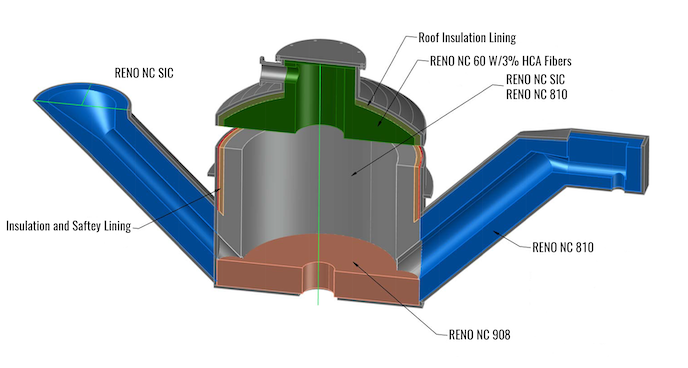
- Roof Insulation Lining
- RENO NC 60 w/3% HCA Fibers
- RENO ElectroCast™ FST
- RENO ElectroCoat™ SP (Surface Treatment)
- RENO ElectroCast SP 392
- RENO Coat IT AL (Steel Shell)
- Insulation and Safety Lining
Ductile Iron Pour Pressure Furnace
Increased Production, and Reduced Cleaning
While in service, the magnesia and calcium carried over from the alloys used in the inoculation process, tends to create a viscous slag layer that can build up on the walls and throat areas. These adherences are very difficult to remove, requiring dangerous hot work to be done on a regular basis. These cleaning activities, reduces valuable production time.
Our super low permeable refractory products, used in many auto-pour and pressure pour furnaces have greatly increased the production time intervals between these cleaning activities, and have lessened the time required to perform the actual cleaning, and increased the refractory life.
Competitive Low Cement Products display a pore size of 20-30 microns.
Our no cement, NC products using the sol gel binder system display pores of 1-2 microns.
RENO ElectroCast™ Products only exhibit pores of 0.5 ~ 0.1 microns!
Throat & Floor
Reno ElectroCast SP 392
While cleaning, the oxygen lance can damage silicon carbide bearing refractory below metal line. This product contains zero carbon, for safer conditions
Insulation & Safety
Floor: ½” Marinite Board, + 3” of 70% Brick
Throats: ¼” Microtherm Overstitch Panels, folded under the brick work
Roof
Insulation and Anchors: 85% Phos Anchor Brick, and ½ Inch Marinite Board
Hot Face: RENO NC 60 with 3% HCA Fibers
Spouts
Hot Face: RENO ElectroCast™ FST
Surface Treatment: RENO ElectroCoat™ SP
Walls
Insulation and Safety:
RENO Coat It AL on Steel Walls, prevents carbon transfer
4.5” Super Duty Brick, arch type for tight construction
1.5 inches of BNZ 2600° F IFB for Insulation
RENO MO Super 3 Mortar
Hot Face:
RENO ElectroCast™ FST
RENO has invested in a new synthetic mineral made exclusively for us. This mineral can tolerate thermal swings, and is non wetting while in contact with iron. Zero Silica composition prevents magnesium fade from ductile iron. Cleaning is made easy and less frequent. New insulation design reduces energy consumption while providing a true safety liner. The freeze plane is well in front of the brick safety lining.
Pouring Box applications
Pouring Boxes, with Stopper Rods
RENO NC 6059 Coarse, RENO ElectroCoat™ 75 SiC, RENO NC 908
Pouring Boxes are a constant source of maintenance, as the indexing molds require even and consistent filling via a nozzle and stopper rod assembly. RENO provides the longest casting solutions with our novel pre-cast Nozzles which dispenses the metal in a constant clean flow rates that do not require the continuous stoppage of the molding lines in order to clean, “ROD-OUT” the nozzles. RENO’s innovative designs allow the interior surfaces to run cleaner and longer for reduced change out sequences, which provides more castings and lower costs.
Hot Face/Surface Treatment
RRENO ElectroCoat™ 75 SiC is a robust, near zero permeability, ceramic coating that resists oxidation. This new surface will: extend the on-line performance time without buildups, greatly lessen the cleaning time, and allows the castable working lining to last many times longer.
Castable Lining
RENO NC 6059 Coarse
This rugged refractory castable is engineered to tolerate extreme thermal cycling, very small pore sizes, which reduce adherences, and easy dry-out characteristics.
Precast Nozzles
RENO leads the industry with clean metal dispensing, with pour-box nozzles fabricated with RENO NC 908. This is our calcium free product that is virtually pure alumina and chrome oxide enhanced for clean and dependable mold filling. At the end of the day, the extra molds filled, adds profits for the foundry operation.
Insulation
2800°F, IFB Brick Split / RENO MO Super 3 Mortar
Safety Steel Surface Treatment
RENO Coat It AL
To prevent Carbon Transfer should molten iron touch the steel shell, which weakens the steel and is the major cause of run-outs, apply this ceramic layer of protection.
Top Cap
It is imperative to keep the castable working lining in compression to avoid horizontal cracking; this can be accomplished by incorporating:
3/8” diameter x # 304 V-Anchors welded on 6-inch centers x a length of approximately 80% of the total lining thickness
4 ~ 6-Inch top-cap of RENO Cast 70 KH HI WIRE
This economical solution can be cast along with castable but the high volume of steel fibers adds a robust, in the field thrust plate barrier to keep the ladle in compression which eliminates cracks and increases life.
Gray Iron Transfer Ladle applications
Gray Iron Transfer Ladles
RENO ElectroCast™ 370 and RENO ElectroCoat™ 75 SiC
Grey Iron Transfer Ladles will perform longer and provide lower turnaround maintenance costs when utilizing these advanced refractory products.
Hot Face/Surface Treatment
RENO ElectroCoat™ 75 SiC is a robust, near zero permeability, ceramic coating that resists oxidation. This new surface will: extend the on-line performance time without buildups, greatly lessen the cleaning time, and allows the castable working lining to last many times longer.
Castable Lining
RENO ElectroCast™ 370
This super refractory is engineered to tolerate thermal cycling and has all the advantages listed for our Electro Castables, such as extremely small pore sizes, and very low permeability, to resist adherences, and very high hot strengths, to combat erosion.
Insulation
2800°F, IFB Brick Split / RENO MO Super 3 Mortar
Safety Surface Treatment
RENO Coat It AL
To prevent Carbon Transfer should molten iron touch the steel shell, which weakens the steel and is the major cause of run-outs, apply this ceramic layer of protection.
Top Cap
It is imperative to keep the castable working lining in compression to avoid horizontal cracking; this can be accomplished by incorporating:
3/8” diameter x # 304 V-Anchors welded on 6-inch centers x a length of approximately 80% of the total lining thickness
4 ~ 6-Inch top-cap of RENO Cast 70 KH HI WIRE
This economical solution can be cast along with castable but the high volume of steel fibers adds a robust, in the field thrust plate barrier to keep the ladle in compression which eliminates cracks and increases life.
Refractory Products for Foundry Maintenance Applications
RENO Refractories, Inc. provides the iron foundries with easy to work with refractory products used for daily maintenance duties. The long list includes:
RENO BlakIce No. 2
General silica / carbon, ladle wash that can be sprayed or brushed on most refractory surfaces. This product works great as the furnace top rings and other ladle free-board slag-splash applications. Some even spray the outside of the ladle steel shells to prevent molten metal / slag splash adherences.
RENO MO Super 3
Fast and strong air setting super duty mortar, used for installing safety lining brick and insulation brick.
RENO 95 HS Mortar
This heat setting mortar can be used for installing brick with high expansion rates, such as tabular alumina type, and for creating gasket seals between receiver and discharge spouts used in conjunction with ceramic paper, etc. It is recommended as the surface preparation before phosphate bonded plastic repairs, versus the air-set mortars that are bonded with sodium silicate. Sodium silicate react with the phosphate chemicals in the plastics and may result in improper bonding.
RENO ElectroCoat™ Vapor Shield
This Near Zero Permeability Surface Treatment is used for applying a vapor resistant barrier between the IMF coil-grout, and the hot-face dry vibe refractory, to prevents zinc vapors from re-condensing on the coils.
RENO ElectroCoat™ 75 SiC
The high amounts of silicon carbide resists oxidation and thus provides protection from the corrosion of metal – slag mixtures. This product bonds to steel and extends the useful life for slagging tools many times. The clean slagging tool also reduces the labor required for cleaning furnaces and ladle slag layers. This unique product is an invaluable asset for reducing labor costs associated with ladle cleaning.
RENO Putty 55
This user-friendly chemical bonded, fine-grained plastic / putty like refractory can be used to form lips, and top-cap rings for slag-splash resistance.
RENO Putty 80 FF
This high alumina chemical bonded product that can be used in a variety of patching applications such as ladles, spouts, troughs and any high wear areas. The special particle sizing used makes the patching product crack free for smooth surfaces.
RENO PL 70 P
This is a phosphate bonded mullite plastic used for patching large areas in ladles, spouts, and troughs. Works best when the used and dry refractory surface is clean from dust and debris, then wet down with a thin layer of RENO Mortar just prior to ramming.
RENO Plastic 85 P
This is a phosphate bonded bauxite plastic used for patching all areas in the foundry, and can many times replace the more expensive 90% products, which are used simply due to the high workability. Applications like the top-cap in the coreless induction melting furnaces are just one of many areas where our 85% alumina, high strength plastic will demonstrate its value.
RENO Plastic 90 P
This is our high purity 90% alumina, phosphate bonded plastic refractory. It is used where high strengths and corrosion resistance are common.
RENO PL 349 CRM
Our tabular alumina phosphate bonded plastic fortified with chrome oxide plastic is used for the most demanding applications such as spout repairs, as well as impact pads, and high wear areas inside the melting furnaces, or areas that require a corrosion resistant refractory.
RENO NC Hot Gun 6044
This is a patching repair gunnite refractory that can be shot over hot surfaces. This is a no-cement, high alumina – silicon carbide refractory composition that applies easily and develops extremely high strengths at use temperatures. Applications include Vertical and Horizontal Induction Furnaces as well as Large Fore-Hearth Ladles where impact streams or slag corrosion gouges the walls and require patching.
RENO Floor Cast
Many high traffic areas around furnaces experience damages from metal or slag spills. These floor areas can be easily repaired with our super strong, high cement content refractory concrete to keep the floor smooth for safe fork-truck operations.
Ceramic Fiber Blanket, Ceramic Insulation Paper, and Sodium Silicate
We stock a variety of ceramic fiber blankets with the one-inch x (8) pound density being the most common. We also have 1/ 8” and ¼” x 2300 ⁰F Ceramic Paper Insulation, and Sodium Silicate for applying these insulation materials.
Microthermal Insulation Panels
RENO provides micro-porous insulation in a quilted glass cloth, which we stock in sizes of 24 inches x 36 inch x ¼ inch thick. We have successfully used this super insulation in many applications where the furnace linings demand steel shell protection or where ladles are not sufficiently thick enough for traditional insulating fire-brick designs. Please discuss with a RENO Technical Engineer before incorporating; it is imperative to calculate the freeze plain designs for safety when considering this super-efficient insulation.
| Reno Standard Foundry Products | |||||||
|---|---|---|---|---|---|---|---|
| No Cement Castables | |||||||
| Product Name | Applications & Special Notes | Chemical Composition | Density | Service Temperature | |||
| Reno NC 50 Coarse | Coreless furnace covers, back up linings, cement kiln preheaters and coolers. Excellent thermal shock & abrasion resistance. | Al₂O₃ 50%-52% SiO₂ 46%-47% | 148 lb/ft³ | 2850°F | |||
| Ladles where iron is hauled. Also precast shapes for iron and steel. Gray iron ladles and runner systems. Excellent resistance to chemical attack & thermal shock. | Al₂O₃ 57%-62% SiO₂ 38%-42% TiO₂ 1.75%-2.0% | 160 lb/ft³ | 3000°F | ||||
| Reno NC 70 | Recommended in areas were chemical attack or thermal cycling are an issue. Applications include chemical processing, iron and steel ladles and power plants, and transfer ladles. Can be dried out faster than typical NC products. | Al₂O₃ 68%-72% SiO₂ 24%-26% | 165 lb/ft³ | 3000°F | |||
| Reno NC 85 | For applications where abrasion, chemical attack or thermal shock are issues. Areas - cement, lime, incineration, boilers, iron, steel and aluminum. | Al₂O₃ 85%-88% SiO₂ 7%-9% TiO₂ 2.5%-3% | 180 lb/ft³ | 3100°F | |||
| Reno NC 90 AR | Excellent resistance to alkalis, thermal shock, iron oxide reaction and penetration. Applications include vertical channel furnace floors, throats, reheat furnace hearths, torpedo ladles, steel ladle barrels, and tundish back-up lining. | Al₂O₃ 89%-90% SiO₂ 5%-6% TiO₂ 2.5%-3% | 190 lb/ft³ | 3100°F | |||
| Reno Cast NC 6059 | High Density low porosity for rapid dry out. Excellent resistance to iron and slag penetration. All Ladles, Ductile or Gray Iron, treatment ladles, pouring boxes for both gray and ductile iron, iron tilters, torpedo and transfer ladles. | Al₂O₃ 81% SiO₂ 8.5% TiO₂ 2.5% SiC+C 8% | 172 lb/ft³ | 3000°F | |||
| Reno Cast NC 6044 | High Density low porosity for rapid dry out. Excellent resistance to iron and slag penetration. All Ladles, Ductile or Gray Iron. Recommended for blast furnace troughs, tilters, torpedo and transfer ladles. | Al₂O₃ 76% SiO₂ 5% TiO₂ 2.5% SiC+C 15%~16% | 172 lb/ft³ | 3000°F | |||
| Reno NC 810 | High density and low porosity. Excellent for slag wear. May be pumped with 3 inch hose. Ductile treatment ladles, furnace receiver and discharge spouts, blast furnace troughs/skimmer-blocks, cupola wells, and treatment ladles. | Al₂O₃ 76% SiO₂ 7% TiO₂ 1.6% SiC+C 15% | 193 lb/ft³ | 3000°F reducing | |||
| Reno NC SiC | Excellent resistance to iron, slag, thermal shock and oxidation. Blast furnace troughs/cupola carbon wells. Can be used where there is a slag wear problem. | Al₂O₃ 8% SiO₂ 7% TiO₂ 1.6% SiC+C 23% | 193 lb/ft³ | 3000°F | |||
| Reno NC 908 | Vertical channel & pressure furnace floors / throats. Used in cupola melt zone, troughs and metal transfer shapes. | Al₂O₃ 89% SiO₂ 6.6% Cr₂O₃ 7.6% | 189 lb/ft³ | 3200°F | |||
| Reno Jet Cast NC ATZ | High density, low porosity, high hot strength w/ rapid dry out characteristics. Excellent for foundry/steel mills with harsh cond. Resists iron, slag, thermal shock and oxidation. Recommended for use in the melt zone of high production cupolas. | Al₂O₃ 69% SiC 25% SiO₂ 4% | 173 lb/ft³ | 3000°F | |||
| Reno ElectroCast™ 1170 | Electro™ series product. Low porosity and a quick dry out. Recommended for transfer ladles and runner systems. | Al₂O₃ 70% SiO₂ 27% | 159 lb/ft³ | 3000°F | |||
| Reno ElectroCast™ 1110 SiC | Electro™ series product with microporosity and high density. Excellent resistance to thermal shocks, metals and slags. Recommended for vertical channel furnace upper walls. Excellent for holding and pressure pours, also, receiver and discharge chutes. | Al₂O₃ 80% SiO₂ 8% TiO₂ 1.7% SiC+C 10% | 196 lb/ft³ | 3000°F | |||
| Reno ElectroCast™ 1116 SiC | Electro™ series product with microporosity and high density. Excellent resistance to thermal shocks, metals and slags. Used in blast furnace troughs/skimmer blocks/tilting runners, wells, troughs/taphole blocks. | Al₂O₃ 76.1% SiO₂ 6.5% TiO₂ 1.4% SiC+C 16% | 196 lb/ft³ | 3000°F | |||
| Reno ElectroPump™ 11808 | Electro™ series product with microporosity and high density. Excellent resistance to thermal shocks, metals and slags. Used in Treatment Ladles, fore-hearth ladles, pouring boxes for both ductile and gray iron. | Al₂O₃ 81% SiO₂ 7%-8% TiO₂ 2%-3% SiC+C 8% | 179 lb/ft³ | 3000°F | |||
| Reno ElectroCast™ 1170 | Electro™ series product with microporosity and high density. Excellent resistance to thermal shocks, metals and slags. Applications include safety linings for tundish, working lining for gray iron ladles, pouring box linings. | Al₂O₃ 70% SiO₂ 27% TiO₂ 2%% Fe₂O₃ 0.7% | 159 lb/ft³ | 3000°F | |||
| Reno FireCast SIC BF | Designed to be installed by vibration casting, pump cast and shotcrete techniques. Used in ductile treatment ladles, furnace receiver and discharge spouts. | Al₂O₃ 68%-72% SiC 14%-17% SiO₂ 8%-10% MgO 1%-2% | 174 lb/ft³ | 3000°F | |||
| Reno FireCast 905 | Designed to be installed by vibration casting, pump cast and shotcrete techniques. Applications include all ladles, ductile or gray iron. | Al₂O₃ 80.5% SiC 5.0 6.2% SiO₂ 8.5% MgO 1.3% | 187 lb/ft³ | 3000°F | |||
| Reno FireCast 70 | "Best value" for No Cement. Use water for mixing. Installed via cast, pump, or shotcrete with magnesium sulfate. Used in gray iron ladles and runner systems. | Al₂O₃ 71.5% SiO₂ 23.7% MgO < 1% | 166 lb/ft³ | 3000°F | |||
| Reno Cast 8510 CR | Silicate bonded chrome and alumina castable refractory. Used for resisting iron oxide and oxidation areas; Cupola siphon, cupola well, vertical channel & pressure furnace floors & throats + reaction chambers for ductile treatment ladles, EAF roof water panels. | Al₂O₃ 82%-85% SiO₂ 3%-4% Cr₂O₃ 5%-8% | 188 lb/ft³ | 3200°F | |||
| Reno Mag Cast 757 CR | Steel contact, magnesia chrome refractory castable. Resists iron oxide and displays low permeability. Applications include well blocks, (Mini Steel) steel ladle impact pads. | MgO 75% Al₂O₃ 8%-9% Fe₂O₃ 4% SiO₂ 4% Cr₂O₃ 7% | 173 lb/ft³ | 3100°F | |||
| Cement Bonded Castables | |||||||
| Product Name | Applications & Special Notes | Chemistry | Density | Service Temp | |||
| Reno Cast 60 L-2 | General purpose alumina castable. Excellent resistance to iron and steel slag. Used in vertical channel furnace roofs. | Al₂O₃ 60% SiO₂ 31% CaO 3.5% | 147 lb/ft³ | 3100°F | |||
| Reno Cast 65 XCLC | High alumina, low cement, low moisture, coarse aggregate product with high strength and abrasions resistance. All Gray Iron Ladles, Runner System | Al₂O₃ 65% SiO₂ 30% CaO 1.7% | 158 lb/ft³ | 3000°F | |||
| Reno Cast 8067 XLC | High alumina, low cement, low moisture, coarse aggregate product. High strength and abrasion resistant at elevated temperatures. Upper and lower rings behind working lining for coreless furnaces. | Al₂O₃ 82%-84% SiO₂ 14% CaO 1%-2% | 172 lb/ft³ | 3200°F | |||
| Reno Iron Cast | High alumina, low cement, SiC product. High density and strength. Good for tilters, holding furnaces, troughs, ladles, treatment ladles for ductile iron. Can be pumped or shotcreted. | Al₂O₃ 79% SiO₂ 9% SiC 8.8% | 180 lb/ft³ | 3000°F | |||
| Reno Cast 95 LCT | Extra high alumina, low cement product. Superior properties and high density/strength. Recommended for vertical channel furnace floors and throat, "high volume". It can easily be installed by vibration casting, pumping or as a self flow. | Al₂O₃ 92% SiO₂ 6% | 190 lb/ft³ | 3200°F | |||
| Ram Products | |||||||
| Product Name | Applications & Special Notes | Chemistry | Density | Service Temp | |||
| Reno Bottom Sand | Silica ram product for insulation over the cupola bottom doors. | Al₂O₃ 18.8% SiO₂ 70.5% | 140 lb/ft³ | 2900°F | |||
| Reno Cupola Bottom Ram | Top cap for cupola bottom doors, | Al₂O₃ 70% SiO₂ 10% C 11% | 170 lb/ft³ | 3000°F | |||
| Reno Rock BTW Ram 2.0 | Very strong resin bonded ramming mix with SiC to withstand harsh/erosive conditions. Ram, Cupola Well & Trough- if they do not wish to use castable. Resists slag attack in taphole, breast area and trough. | Al₂O₃ 63% SiO₂ 4.7% SiC 24.7% | 189 lb/ft³ | 3000°F | |||
| Reno Sil 0.8 | Silica based dry vibratable product used for lining induction furnaces. | Al₂O₃ 0.5%-1% SiO₂ 98%-98.5% B₂O₃ 0.8% | 128 lb/ft³ | 3100°F | |||
| Reno Sil 1.0 | Silica based dry vibratable product used for lining induction furnaces. | Al₂O₃3 0.5%-1% SiO₂ 98%-98.5% B₂O₃ 1.0% | 127 lb/ft³ | 3100°F | |||
| Reno ElectroSil 1.0 | Electrobond additives to control electro-static charges allows more uniform structure, and low dust. Dry vibratable product used for lining induction furnaces. | Al₂O₃ 0.5%-1% SiO₂ 97.5%-98% B₂O₃ 1.0% | 127 lb/ft³ | 3100°F | |||
| Reno RM 50 PV | Alumina phosphate bonded vibratable ram product. Good thermal expansion at high temperatures. Applications include pouring ladles that are used to dispense into molds, iron is cooler, requires minimum skill, no mixing, only a form air vibrator. | Al2O3 51% SiO₂ 43.5% | 155 lb/ft³ | 3050°F | |||
| Light Weight Products | |||||||
| Product Name | Applications & Special Notes | Chemistry | Density | Service Temp | |||
| Reno Lite 24-60 | Light weight strong insulating castable (2400°F) Used in pressure pour roofs. | Al₂O₃ 48% SiO₂ 37% CaO 7.6% | 57-62lb/ft³ | 2450°F | |||
| Reno GN 25 LW | Strong, hydraulic setting, insulating gun mix. Light weight insulation for consteel hoods. | Al₂O₃ 48% SiO₂ 37% CaO 7.6% | 72 lb/ft³ | 2500°F | |||
| Reno Lite 60 EX | Strong, hydraulic setting, insulating gun mix. Can be installed by either cast or gun methods. | Al₂O₃ 48% SiO₂ 37% CaO 7.6% | 72 lb/ft³ | 2500°F | |||
| Reno Cast 115 | Strong, hydraulic setting insulating castable mix. Reduces heat loss, mixes with water and easy to work with. Applications include cast pouring ladles, at the end of the process, iron temps below 2500°F, imperative to cover the surface with Reno ElectroCoat 75 SiC, for Gray Iron; or Reno Mag Seal, for Ductile Iron, upgrade for VCF Roofs. | Al₂O₃ 51.4% SiO₂ 33.3% CaO 12.0% | 120 lb/ft³ | 2700°F | |||
| Plastic Products | |||||||
| Product Name | Applications & Special Notes | Chemistry | Density | Service Temp | |||
| Reno PL 70 P | Plastic material for iron runners. Rammed plastic with good workability and resists spalling. Used to patch ladles, or runners. | Al₂O₃ 70% SiO₂ 24% | 165 lb/ft³ | 3100°F | |||
| Reno Plastic 80 AF | High purity, high alumina, fine grained chemically bonded plastic; Similar to putty will not crack. Patch material for runners and ladles. | Al₂O₃ 85% SiO₂ 5%-6% | 175 lb/ft³ | 3200°F | |||
| Reno Plastic 85 P | High purity, high alumina, fine grained chemically bonded plastic. Install as the impact top-cap for coreless furnaces. | Al₂O₃ 84% SiO₂ 8%-9% | 178 lb/ft³ | 3100°F | |||
| Reno Plastic 90 P | High purity, high alumina phos. bonded plastic. Exhibits excellent hot strengths, high density and volume stability. Appropriate for impact pads for high volume ladles and other severe applications. | Al₂O₃ 90% SiO₂ 4.9% | 180 lb/ft³ | 3200°F | |||
| Reno PL 70 P CRM | High alumina phos. bonded plastic with chrome oxide. High density and low porosity reduces metal penetration effects of corrosive slags. Resists spalling. Used in coreless furnace spouts, patching interior of treatment ladles. | Al₂O₃ 66% SiO₂ 24% Cr₂O₃ 4%-5% | 170 lb/ft³ | 3100°F | |||
| Reno PL 349 CRM 7 | High alumina chrome phos. bonded plastic. Used in coreless furnace spouts and as a patch for interior of treatment ladles. | Al₂O₃ 85% SiO₂ 3.7% Cr₂O₃ 7% | 200 lb/ft³ | 3400°F | |||
| Reno Rock BTW Plastic 2.0 | Strong resin bonded plastic containing SiC. Developed to withstand harsh erosive slag attack. Excellent material taphole, breast area and trough. Installed with rammers. | Al₂O₃ 63% SiO₂ 6% SiC 23% | 188 lb/ft³ | 3000°F | |||
| Gunning Products | |||||||
| Product Name | Applications & Special Notes | Chemistry | Density | Service Temp | |||
| Reno Gun 80 P | Special adherence no-cement, hot-gunning product for re-surfacing slag lines in vertical channel furnaces, or any hot gun ladle needs, replace gunned plastic in aluminum-furnace repairs, almost zero re-bound, easy to apply. | Al₂O₃ 81.3% SiO₂ 9.3% MgO 2.4% | 145 lb/ft³ | 3000°F | |||
| Reno NC Gun 70 | High alumina, no cement gunning mix. Hight hot strength, thermal shock resistant, and iron oxide penetration resistant. Used in gunnite quench chamber, and cross over duct. | Al₂O₃ 65%-67% SiO₂ 30%-32% | 150 lb/ft³ | 3000°F | |||
| Reno NC Gun 85 SiC | High SiC, no cement, gunnite material developed to be resistant to iron and slag. High strength and low porosity make this a useful product for gunnite repair of the cupola melt zone from well to 10 feet above tuyeres. | Al₂O₃ 9.4% SiO₂ 3.4% SiC+C 85% | 158 lb/ft³ | 3100°F | |||
| Reno NC Gun 6044 | High alumina and SiC, no cement, gunning product. Excellent resistance to iron, slag, and thermal shock. Applications include gun interior for all vertical channel furnace walls. | Al₂O₃ 74% SiO₂ 7% SiC+C 15%-16% | 160 lb/ft³ | 3000°F | |||
| Reno NC Hot Gun 6044 | High alumina and SiC, no cement, gunning product. Excellent resistance to iron, slag, and thermal shock. Applications include gun interior for all vertical channel furnace walls. | Al₂O₃ 74% SiO₂ 7% SiC+C 15%-16% | 160 lb/ft³ | 3000°F | |||
| Reno Gun 8510 CR | Silicate bonded chrome alumina gun mix. Developed as a gunnite repair to cupola melt zone from Well to 8-feet above tuyeres. | Al₂O₃ 82%-85% SiO₂ 3%-4% Fe₂O₃ 3%-4% Cr₂O₃ 5%-8% | 198 lb/ft³ | 3200°F | |||
| Reno Mag Gun 826 CR | Silicate bonded magnesium chrome mix. Good thermal shock for basic steel making at temps of 3200°F. Gunnite Repair for steel melting furnaces, EAF, vacuum de-gassing snorkels and roofs, and steel ladles. | MgO 81%-83% Al₂O₃ 2%-3% SiO₂ 3%-4% CaO 1%-2% Cr₂O₃ 5%-6% | 152 lb/ft³ | 3200°F | |||
| Reno ASAP Gun 80 ABR | Low cement product designed for accelerated dryout. Must be pre-dampened and gunned into place. High strength and abrasion resistant gunnite repair material for cupola stack near charge opening, lime plants, and HPI/CFB units. | Al₂O₃ 77.8% SiO₂ 16.3% CaO 1.8% | 158 lb/ft³ | 3000°F | |||
| Reno ASAP Gun 60 ABR | High strength, low cement product designed for accelerated dryout. Must be pre-dampened and gunned into place. Special abrasion resistant gunnite repair material for cupola stack, near charge opening and all lime plants, and HPI/CFB units. | Al₂O₃ 58.5% SiO₂ 34% CaO 1.1% TiO₂ 1.8% | 155 lb/ft³ | 3000°F | |||
| Reno Gun 2850 | High density, low iron, general purpose gunning castable for 2850°F. Either used as new lining or patch material. Gunnite repair splash pits and slag spill areas. | Al₂O₃ 48%-50% SiO₂ 40%-43% CaO 5.5%-6.3%, | 135 lb/ft³ | 2850°F | |||
| Reno Gun BTW | Pre-dampened SiC gunning mix for maintenance of carbon wells in high production cupolas. Gunnite Repair for the Cupola Well. | Al₂O₃ 45.9% SiO₂ 10.4% TiO₂ 3%-4% SiC+C 39%-41% | 153 lb/ft³ | 3000°F | |||
| ElectroVibe Products | |||||||
| Product Name | Applications & Special Notes | Chemistry | Density | Service Temp | |||
| Reno ElectroSil 1.0 | Silica based product with unique additives to control electro-static charges, allows more uniform structure. Dry vibratable product for use in all coreless furnaces melting iron. | Al₂O₃ 0.5%-1% SiO₂ 97.5%-98% B₂O₃ 1.0% | 127 lb/ft³ | 3100°F | |||
| Reno ElectroVibe 92 | High purity, fused alumina product with special Electro-bond additives. High performance due to super low porosity, dust suppressed high alumina mullite bond for channel and pressure pour furnace floor and throat. Resists erosion from iron velocities near inductor. | Al₂O₃ 91% SiO₂ 5% | 185 lb/ft³ | 3000°F | |||
| Reno ElectroVibe 869 | Fused alumina and SiC containing product with special Electro-Bond additives. High Performance due to super low porosity, dust suppressed. For channel and pressure pour furnace upper case walls and back-up safety lining for precast wall systems. | Al₂O₃ 83% SiO₂ 2.5% SiC 9.3% | 175 lb/ft³ | 3000°F | |||
| Reno ElectroVibe 943 M | Special Electro-Bond additives, high performance due to super low porosity, dust suppressed spinel forming for channel and pressure pour furnace inductors and steel melting coreless induction melting furnaces. | Al₂O₃ 93% MgO 3% | 175 lb/ft³ | 3000°F | |||
| Reno ElectroVibe 8315 M | Special Electro-Bond additives, high performance due to super low porosity, dust suppressed spinel forming for channel and pressure pour furnace inductors and steel melting coreless induction melting furnaces. | Al₂O₃ 88.3% MgO 9.34% | 175~222.4lb/ft³ | 3000°F | |||
| Reno ElectroVibe 1088 M | High purity magnesite based spinel material with special Electro-Bond additives and increased corrosion resistance against suspended iron oxide nano-particles present in iron. | MgO 87.82% Al₂O₃ 5.08% | 164~210lb/ft³ | 3200°F | |||
| Mortars & Coatings | |||||||
| Product Name | Applications & Special Notes | Chemistry | Density | Service Temp | |||
| Reno MO Super 3 | Air-set mortar, works great for troweling, Bricks, IFB, and Boards, etc. | Al₂O₃3 44%-46% SiO₂ 47%-49% | N/A | 3000°F | |||
| Reno MO 80 PT | High alumina class phosphate bonded with mortar. Used for laying alumina brick, gasket joints, Mortar/Paper/Mortar. Discharge and receiver spouts + cover silica dry vibe prior to ramming Reno Plastic 85 P - Top Cap. | Al₂O₃ 78.8% SiO₂ 11.2% | N/A | 3200°F | |||
| Reno Blak ICE 2 | High duty carbon wash material used to resist iron/slag penetration. Used in cupola runner troughs and all gray iron ladles. | Al₂O₃ 6% SiO₂ 74% C 17.5% | 96 lb/ft³ | 2900°F | |||
| Reno Silver Bull (Dry) | Super duty air set maintenance spray. Dry product, mix with water. Applications include cupola runner troughs and gray iron ladles. | Al₂O₃ 41% SiO₂ 53% | N/A | 3000°F | |||
| Reno Putty 55 | High alumina phosphate bonded patching refractory. Used for making gaskets between treatment ladles and tundishes. | Al₂O₃ 55% SiO₂ 39% | 150 lb/ft³ | 3000°F | |||
| Reno Putty 80 FF | High purity, high alumina, plastic refractory. High density and low porosity reduces penetration. Used as a patch for all refractory surfaces, will not crack, packaged in a plastic pail. | Al₂O₃ 85% SiO₂ 5%-6% | 175 lb/ft³ | 3200°F | |||
| Reno Putty CRM | High purity, high alumina chrome plastic refractory. High density and low porosity reduces penetration. Patches the interior division walls for treatment ladles. | Al₂O₃ 80% SiO₂ 4.5% Cr₂O₃ 10.5% | 160 lb/ft³ | 3200°F | |||
| Reno Coat IT AL | Protective surface coating applied to steel shell, transferring molten Iron, product bonds to steel & provides a carbon transfer barrier, iron freezes before it pushes through the relaxed steel shell. An insurance layer well worth the investment. | Al₂O₃ 92% SiO₂ 7.7% | 185 lb/ft³ | 2900°F | |||
| Reno Grout 90 | High alumina, no free silica, no iron, cement bonded grout for coreless induction furnaces. Excellent adherences. Apply over coils in coreless induction melting furnaces. | Al₂O₃ 85%-90% SiO₂ 4%-5% CaO 4%-5% | 152 lb/ft³ | 3000°F | |||
| Reno ElectroCoat 75 SiC | SiC based ceramic coating with high density micro-porosity, low permeability and non-wetting. Surface treatment for all gray iron contact, and skimming tools. | Al₂O₃ 12.7% SiO₂ 12.9% SiC+C 73% | 147 lb/ft³ | 3000°F | |||
| Reno ElectroCoat Vapor Shield | Unique Product for adding a vapor barrier protection for the coreless furnace grout layer, super low permeability at low temperatures, prevents zinc vapors from condensing on copper coils. Designed for linings exposed to iron and steel using galvanized scrap. | Al₂O₃ 96% SiO₂ 2.3% | 159 lb/ft³ | 3000°F | |||
| Reno ElectroCoat SP | Ceramic coating for refractory linings exposed to molten slag, iron or steel. Can be used on steel shell. | Al₂O₃ 75% SiO₂ 0.44% MgO 23% | 170 lb/ft³ | 3100°F | |||
| Reno Mag Seal | Sintered magnesia, air setting treatment coating. Designed for refractory linings exposed to molten slag, ductile iron and steel. Product is designed to prevent mag-fade in ductile iron vessels. | MgO 75% Al2O3 3.7% SiO₂ 16% | 126 lb/ft³ (approx. 2.6 lb/ft² at 1/4" thick) | 3000°F | |||
| Mastermelt Oxygen Removal | |||||||
| Product Name | Applications & Special Notes | Chemistry | |||||
| Mastermelt De-OX | Removes oxygen from iron | C + SiC near 99% | |||||
| Mastermelt De-OX D-1 | Removes oxygen from iron (low sulphur version) | C + SiC near 99% -lower sulfur for ductile iron | |||||
| Insulation Products | |||||||
| Product Name | Applications & Special Notes | Chemistry | Density | Service Temp | |||
| Ceramic Fiber Blanket | 8 lb. General Purpose Ceramic Fiber Blanket | HP 1" x 24" x 25 feet long | 8 lbs. | 2300°F | |||
| Ceramic Insulation Paper | General Purpose Ceramic Insulation Paper, use for insulating ladle & furnace shells, spouts, or making gaskets in conjunction with Reno MO 80 PT | HP 1/8" x 24" x 100 feet long | 12.5 lbs. | 2300°F | |||
| Ceramic Fiber Paper | General Purpose Ceramic Insulation Paper, use for insulating ladle & furnace shells, spouts, or making gaskets in conjunction with Reno MO 80 PT | HP 1/4" x 24" x 50 feet long | 12.5 lbs. | 2300°F | |||
| Mica Slip Plane Roll | Separates refractory lining from coil grout in coreless induction furnaces | 1 meter wide x 25 meters long 0.25mm thickness Phlogopite/Silicone resin | N/A | 2200°F | |||

